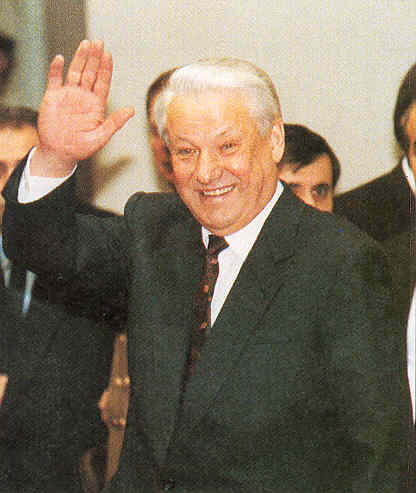|
|
|
Surprisingly Deng held for himself only the position of head of the party's Central Military Commission. Nonetheless from this position Deng held tight control over Chinese politics during the entire 1980s.In 1981 Jiang Qing and the other three members of the radical Maoist "Gang of Four" were put on trial for treason. All four were convicted and the Maoist radical wing of the Party seemed thoroughly discredited.
Deng now moved China toward his more "pragmatic" approach to reform ... opening up the Chinese economy to western capitalist ways.
America and the West were quick to respond in a very positive way ... and the Chinese economy began to boom under Deng's reforms.
|
|
Major economic difficulties At the same time, the Soviet Communist or 'command' economy was finding itself in serious trouble. The Soviets needed hard currency – and soon. Soviet farming had never done well since the days of Stalin's forced collectivization – and Russia, once a major exporter of grain, long had to import grain to feed its people, a great burden on its foreign currency reserves. Also the high cost of Soviet armaments had long cut into the ability the state to offer its people a level of civilian material housing and comforts that a ‘workers’ paradise’ should have had. Most Soviet workers knew well that their worker counterparts in the capitalist West lived much better off than they did. In the Soviet Union, the workers’ paradise had the feel of a Third World country. This in turn was creating a decided drop in ‘working class patriotism’ which was taking the form of a large amount of worker absenteeism at the job site – and even when workers did show up, it was not unusual for them to be drunk. The Soviet economy was in trouble – big trouble. The one thing Russia had in ample supply that was greatly needed abroad and could bring in hard currency to finance Soviet economic shortcomings was ... oil. Thus the Soviet Union’s decision in 1982 to break from the oil pricing of the OPEC oil cartel and sell oil, lots of oil, for whatever price it could get. And with the underbidding of oil pricing by the Soviets, the price of oil came tumbling down. But the Soviets would not reap the windfall from oil that they had been hoping for. Indeed many of the oil exporting nations found themselves in difficulty as their expected revenue from oil dropped away and they had to cut back drastically on investment plans for growth. |
The malaise spreads to the Soviet empire in East Europe
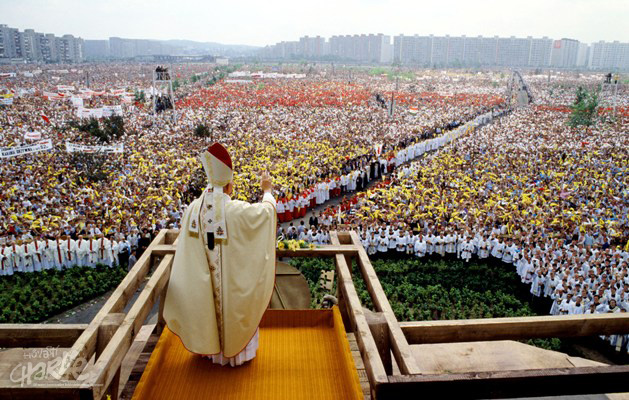
The huge Polish reception
to Pope John Paul II's visit in June of 1979
constituted a huge challenge
to the authority of the Polish Communists
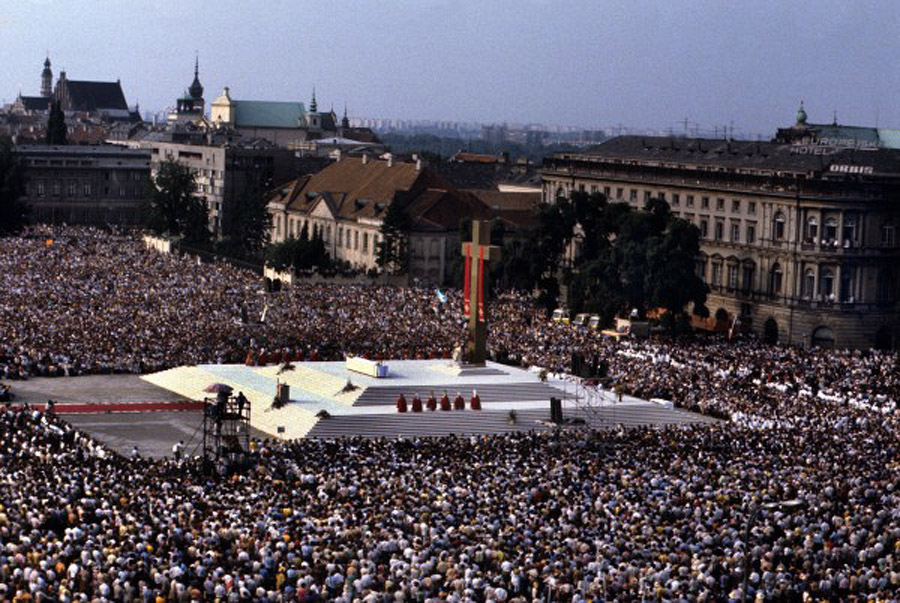
The, led by Lech Walesa's and his dock-workers' union 'Solidarity,'
Polish workers give serious
affront to the Communist system in Poland
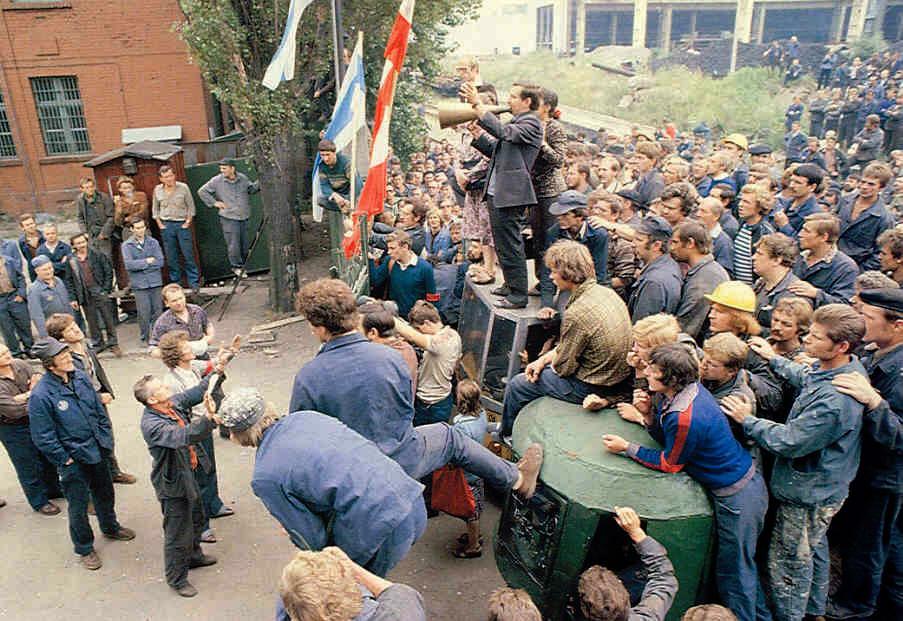
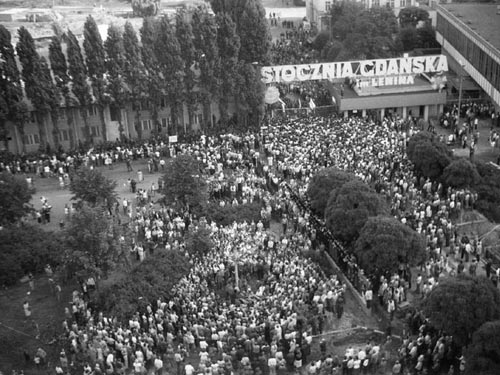
Striking workers at the Lenin
Shipyard - 1980
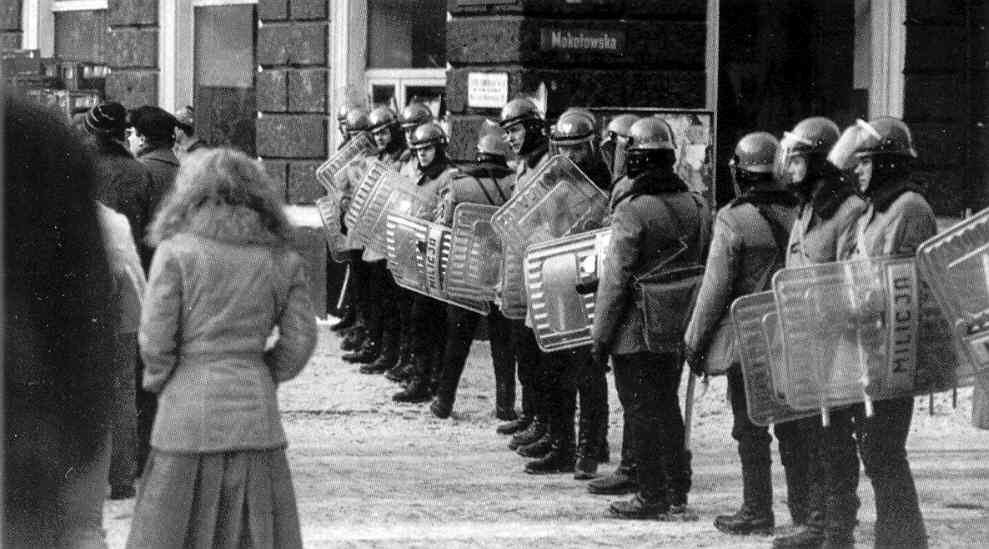
|
The rapid turnover in Soviet leadership (1982-1985) To make matters worse for the Soviets, their country (and empire) was to undergo a rapid turnover of leadership in the next few years, weakening considerable the position of the Soviet leadership both within the Soviet Union itself and more broadly within its Eastern European Empire. When Brezhnev died in late 1982 he was replaced as head of the regime by a KGB hardliner, Andropov. Andropov tried to tighten party discipline and clamp down on the political dissent that was spreading rapidly around the country. But his health was failing and only a little over a year later he died. He was replaced by another equally sick official, Chernenko, who served as Soviet leader no more than a year before he too died. He in turn in early 1985 was replaced,
but this time by a younger and reform minded Gorbachev, who knew that something
dramatic was going to have to take place to save the Soviet Union from
simply collapsing. |
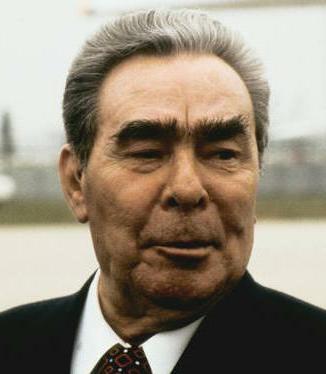
Leonid Brezhnev
Communist Party Chairman 1964-1982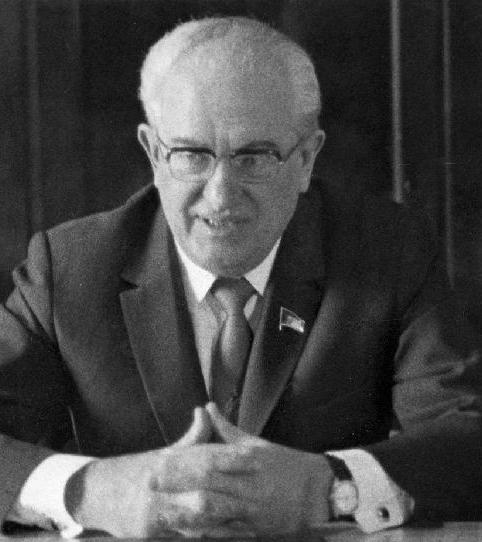
Yuri Andropov
Communist Party Chairman 1982-1984
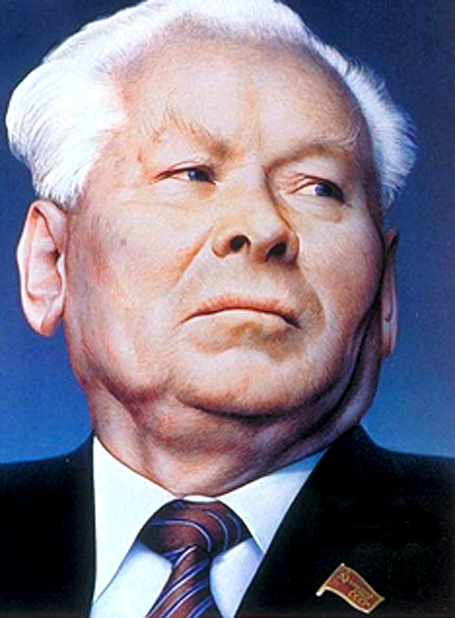
Konstantin Cernenko
Communist Party Chairman 1984-1985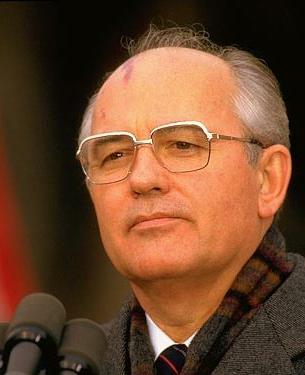
Mikhail Gorbachev
Communist Party Chairman 1985-1991
The Soviet Quagmire in Afghanistan Meanwhile, a major effort of the Soviets to position themselves securely in Afghanistan was not going well. The Soviets wanted this position badly, for it would place them strategically very near the entrance/exit point of the Persian Gulf where much of the Middle East's oil came through on its way to Europe ... and thus offer the Soviets a strong negotiating hand in their dealings with the West.
The Muslim revolution in Iran had quickly spilled over into neighboring Afghanistan in the early 1980s as Afghani Muslims answered the call to jihad (the destruction of Evil) against the Soviets and their puppet Communist regime in Kabul.
Meanwhile America, for obvious reasons (obvious to the political 'Realist' Reagan at least), did not want the Soviets in Afghanistan and was supplying the Afghan rebels, the mujahedin, with advanced missiles that could easily kill Soviet tanks and jets. Consequently, the Soviets were finding themselves bogged down in a war that even with a massive military presence in the country, they could not bring to a favorable close. It was as if Afghanistan were the Soviets’ ‘Vietnam.’ Soon anti-war feelings began to grow within Russian society – and even within the military itself. Russia was in deep trouble in Afghanistan.
Reagan puts on the pressureMeanwhile Reagan was pushing and pressuring the Soviets in every way possible. He sensed the Soviet economic (and moral) decline and intended to exploit it. He threw down the challenge to Russia in a speech before the British Parliament in 1982 when he called the Soviet Union an ‘Evil Empire’ and predicted its collapse in the near future.
Soon thereafter Reagan restored the B-1 bomber program that Carter had canceled, armed NATO with Pershing II missiles, and announced plans to develop and deploy missiles capable of defending America from a missile attack from any enemy.
Not surprisingly, the reaction of the ‘anti-imperialist’ sector of American politics was to loudly denounce Reagan’s ‘war-mongering’ ways. But again, his toughness drew the approval of the majority of Americans, tired of the weakened position in which Carter's 'nice' but feeble responses to the world's challenges had left the country.
The Soviet position in Afghanistan begins to come apart (early 1980s)
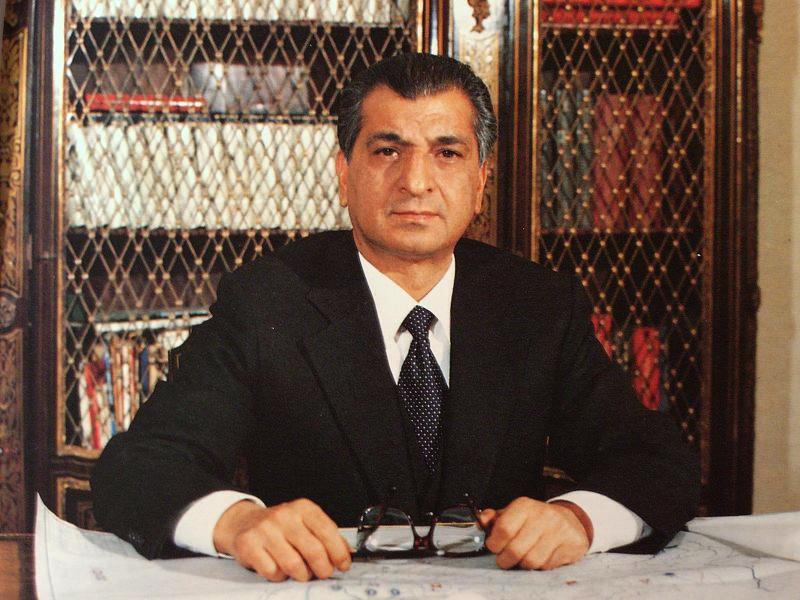
Babrak Karmal, chairman of
Revolutionary Council of the Democratic Republic of Afghanistan
(1979-1986)
The Soviets had installed
this Afghan Communist leader in Kabul in 1979 in the hopes that he might
keep more effective control over
Afghan politics than had
his predecessor, Hafizullah Amin (whom Soviet troops assassinated
when they first invaded the country in 1979)
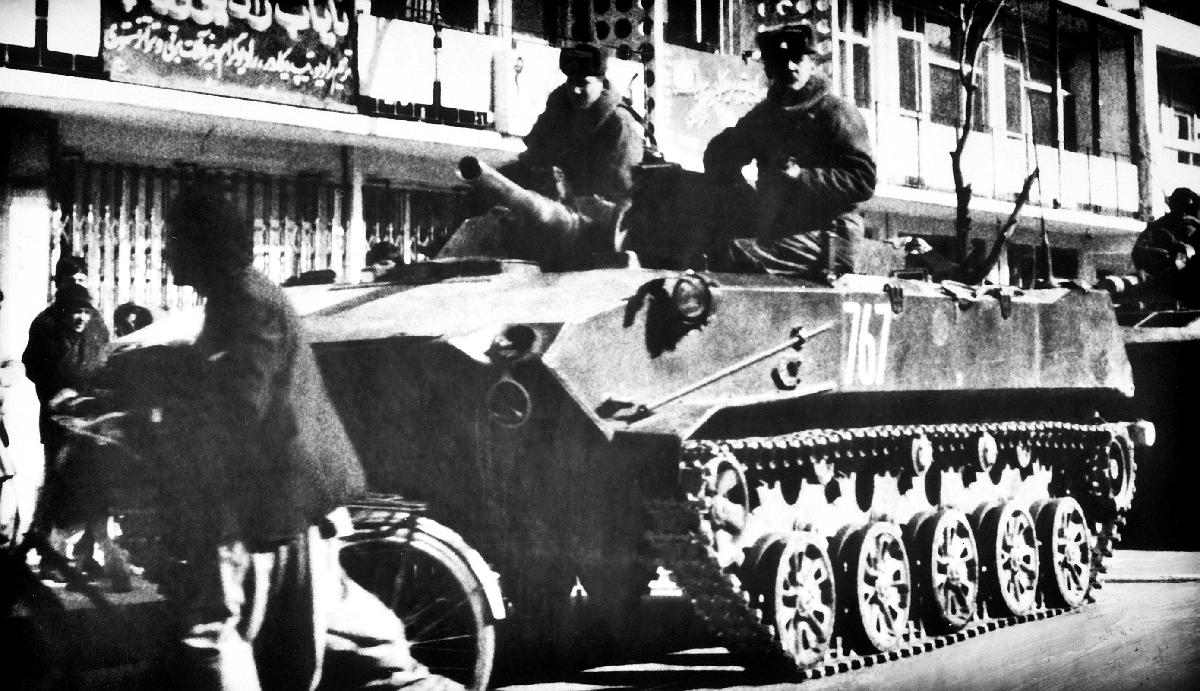
Soviet paratroopers aboard
a BMD-1 in Kabul
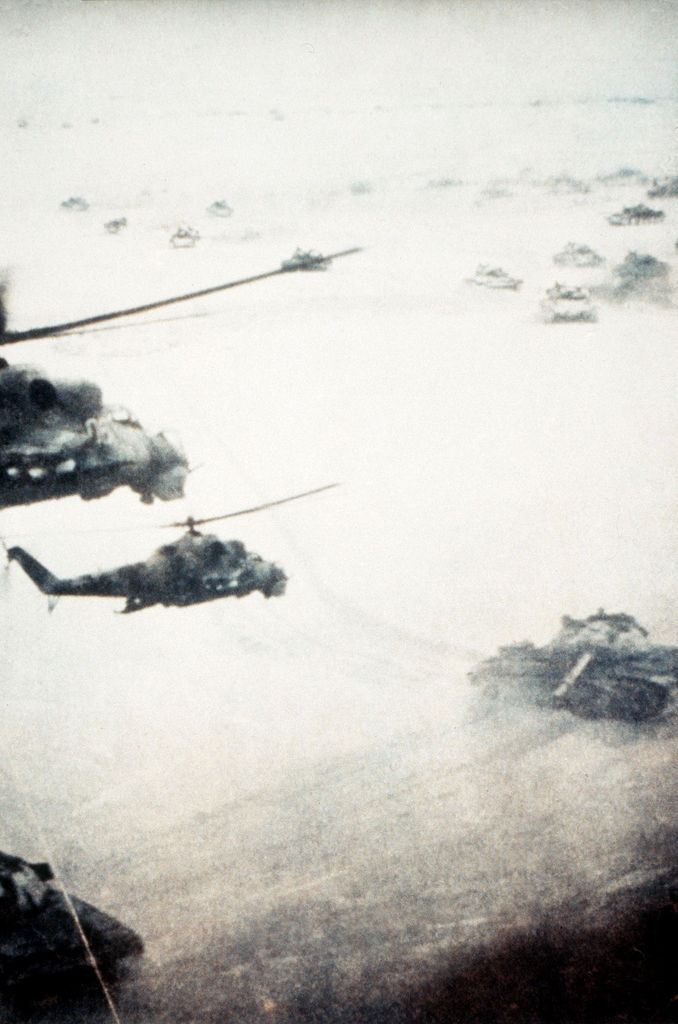
Soviet helicopters working
with Soviet tanks in Afghanistan
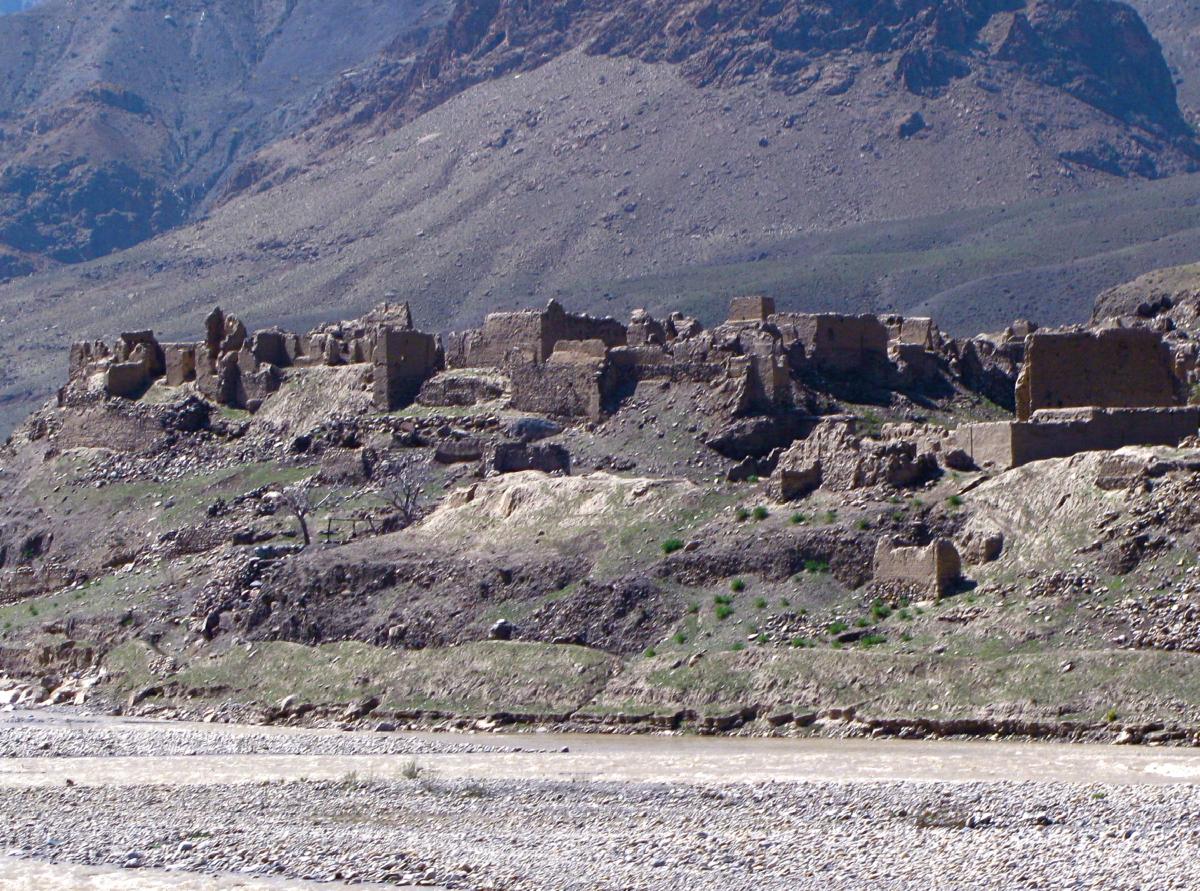
Afghan village destroyed by Soviet troops
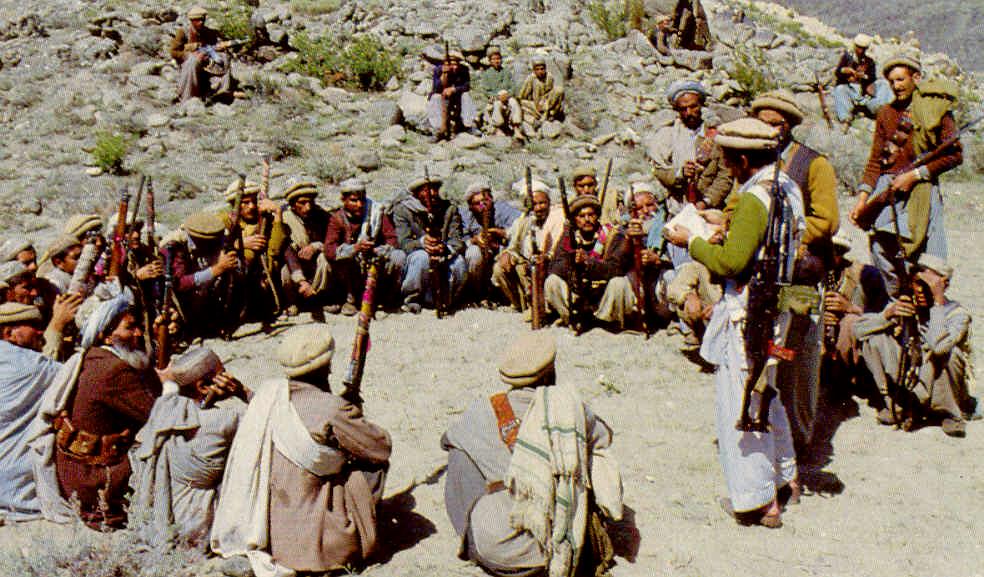
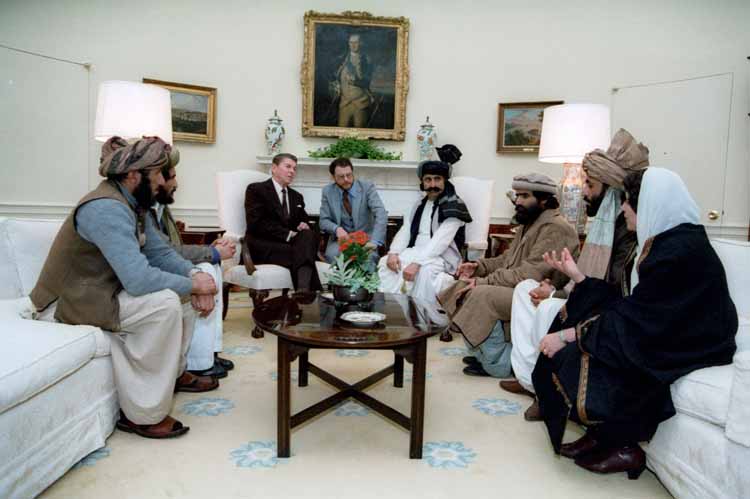
Reagan listening to the
mujahidin's
description of Soviet atrocities in Afghanistan - February 1983
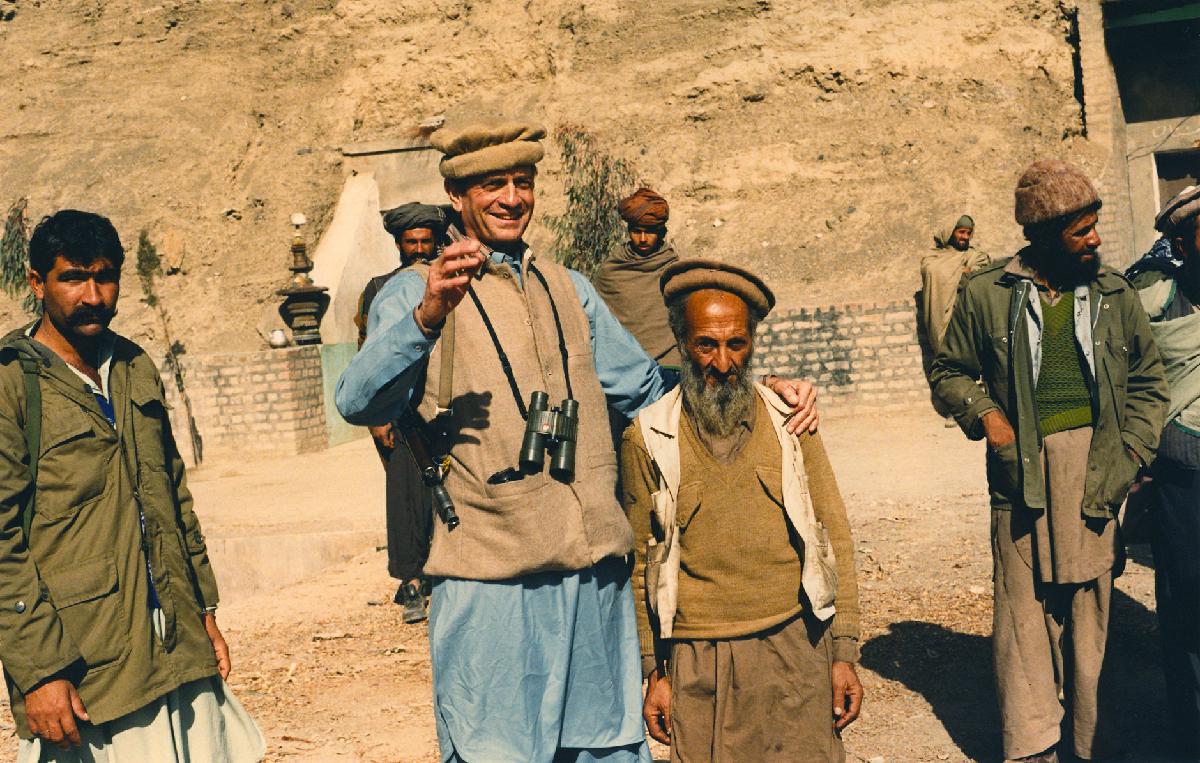
Texas Congressman Charlie
Wilson in Afghanistan
Wilson was a prime mover
in Operation Cyclone, in which the US sent $ millions to support the
mujahidin
in their fight against the
Soviets (unfortunately much of the money ended up in corrupt Pakistani
military hands)
Resistance by conservative
Muslim mujahidin however is grinding down the Soviet effort
to maintain Communist control
in Afghanistan
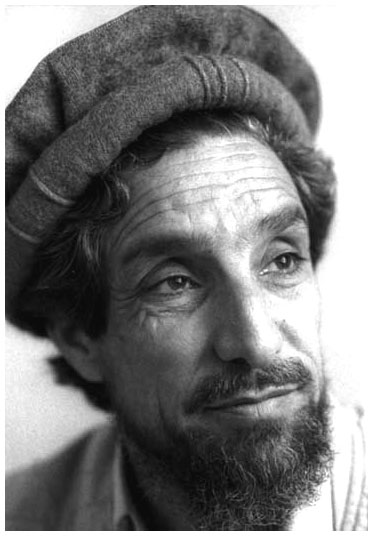
Ahmad Shah Massoud - the
"Lion of Panjshir"
This engineer turned mujahidin
proved to the the most effective of the Afghan resistance commanders
(When the Taliban later
took over the country he became their prime opponent; the Taliban
assassinated him just days
before the September 11, 2001 attack on the New York Twin
Towers)
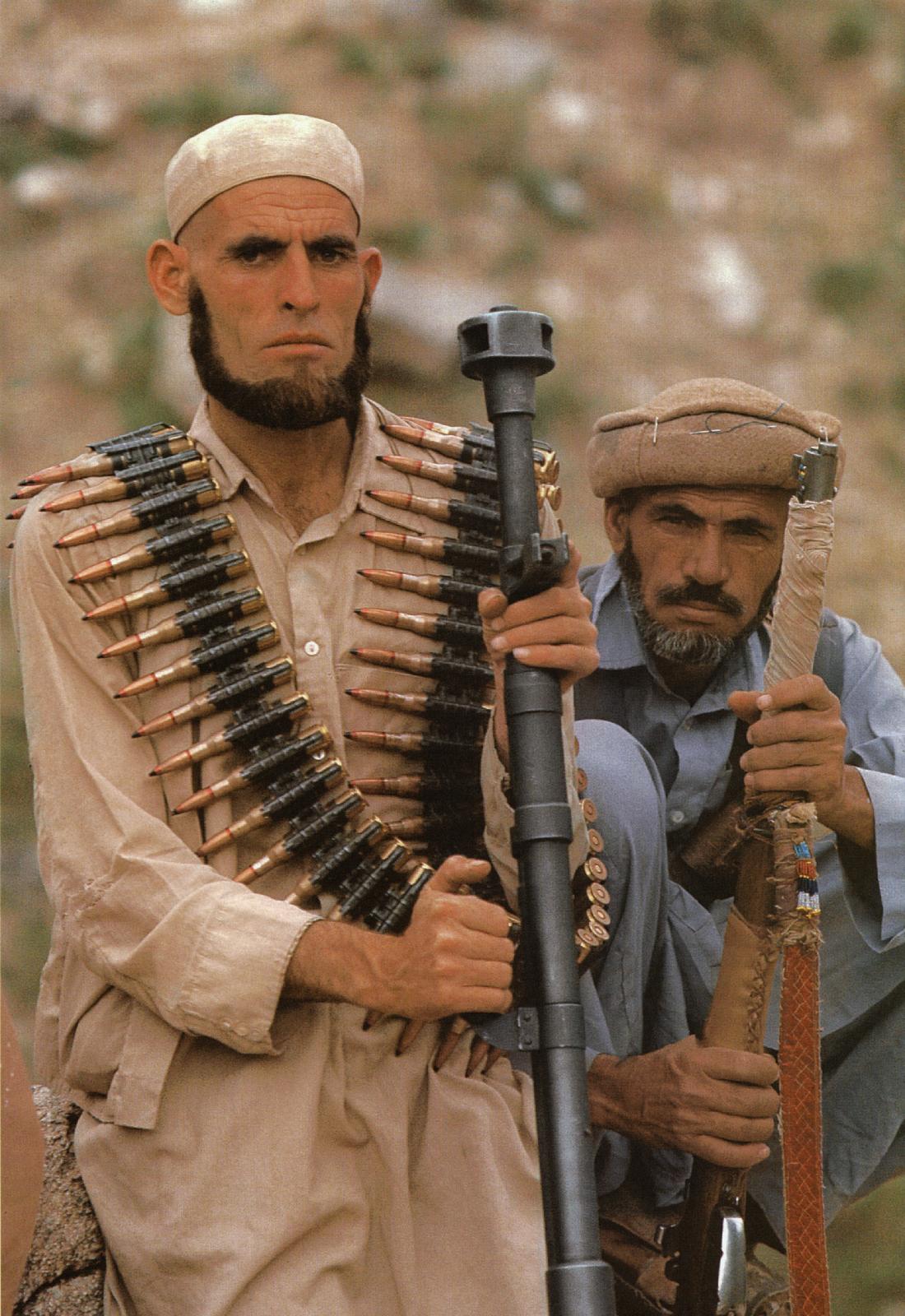
Well armed mujahedin
confronting
Soviet troops in Afghanistan
|
Gorbachev All of this challenged Russia in a way that the new Soviet Premier Mikhail Gorbachev knew that his country could not effectively answer. Gorbachev responded instead by offers of a new look to the Soviet Union and a new attitude toward the West. In part, he was simply taking a page from Chinese leader Deng Xiaoping, impressed by how China's new pro-Western policies were bringing China finally to prosperity. Reagan, while carrying Teddy Roosevelt’s, ‘Big Stick’ (his ramping up of America’s defense posture) was also ready to follow Roosevelt’s policy of also 'walking softly' with respect to the Soviet Union’s new leader Gorbachev. Reagan began to meet with Gorbachev to see what possibilities existed to work through a new thaw in East West relations. Meanwhile Gorbachev began to put into operation his reforms for Russia, the most important of which were glasnost (a new openness in the society), perestroika (a restructuring of the economic system) and demokratizatsiya (democratization of the political system). This was designed to put a new lease on life on Communism. Gorbachev's reforms were greeted with great enthusiasm everywhere, in Russia, in Eastern Europe and even in America. |
Gorbachev was pushing for a new face to Communism with the policies of perestroika and glasnost.
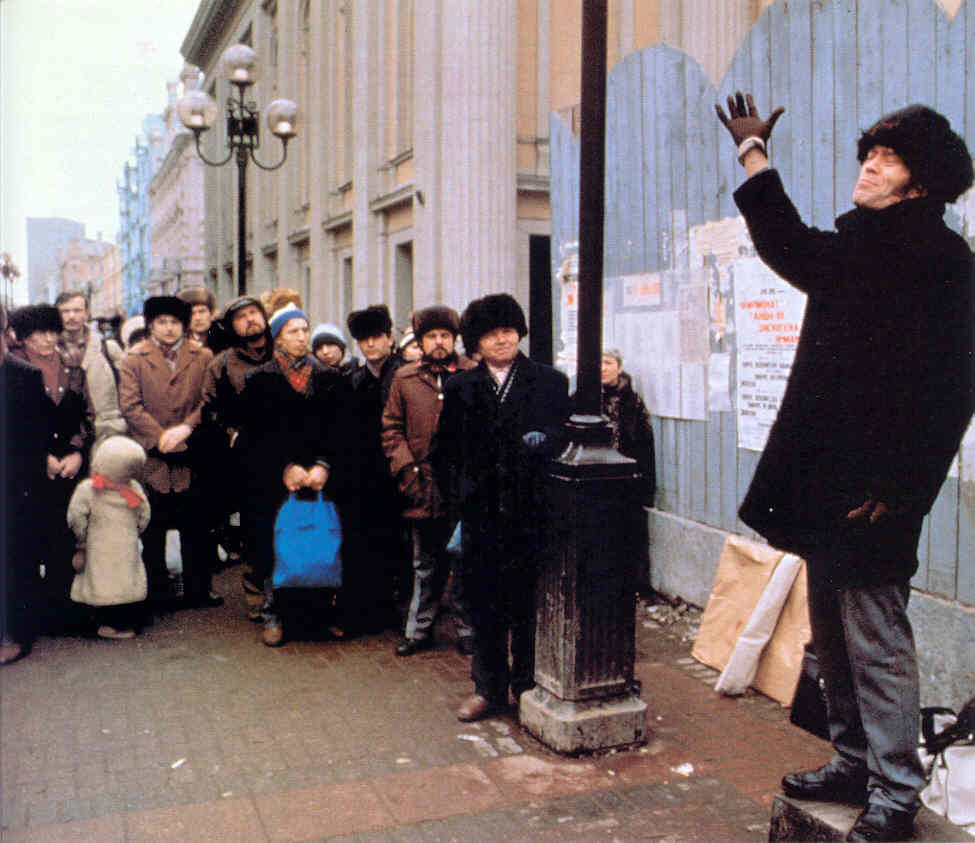
A Russian practicing
glasnost
on a Russian street
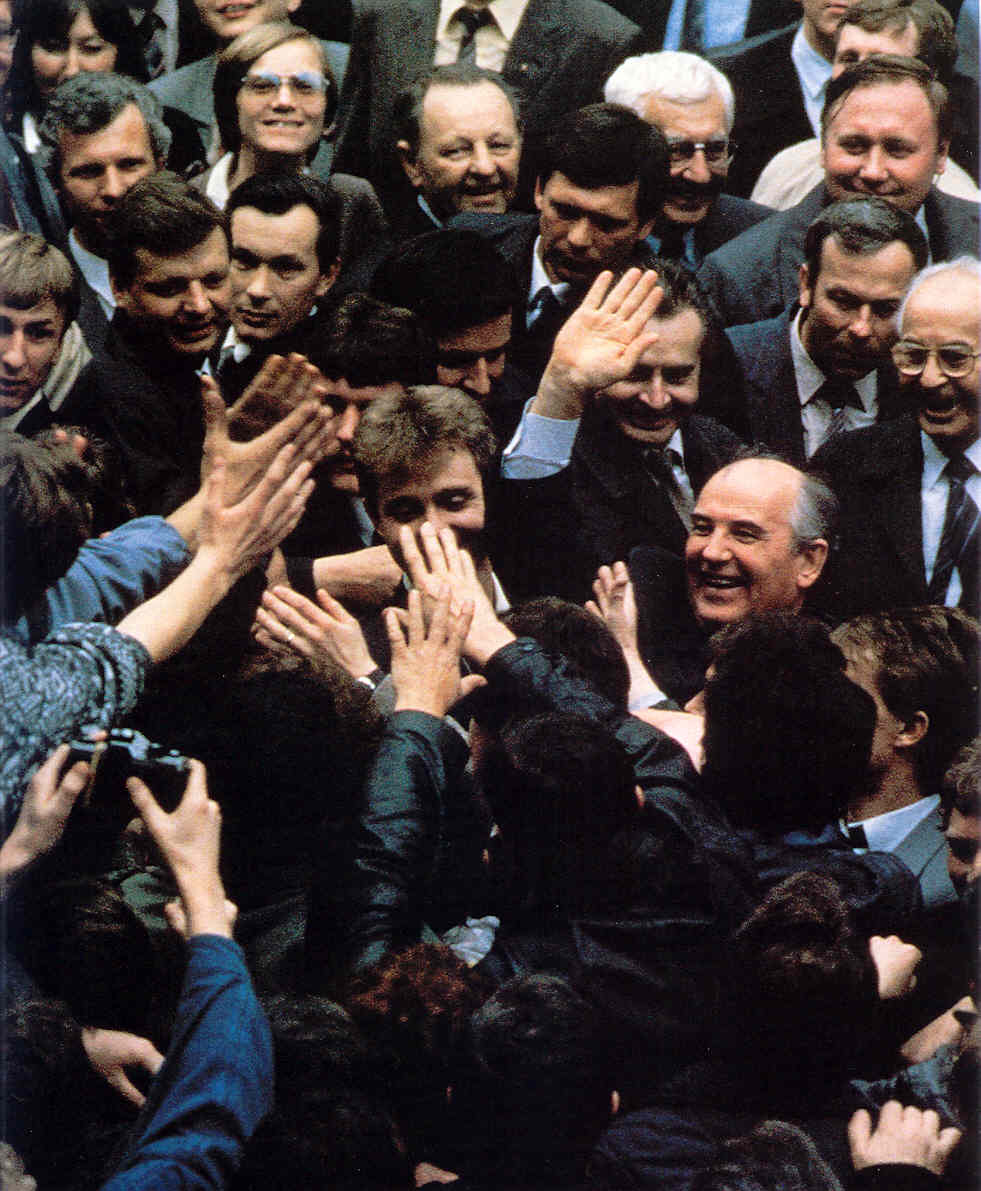
Gorbachev welcomed in Prague
for his reforms
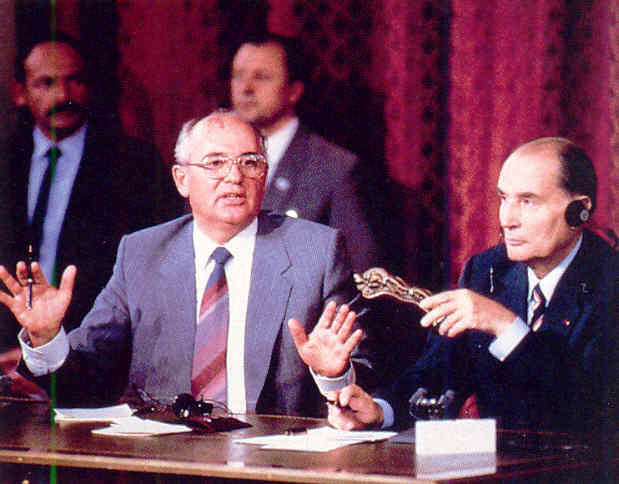
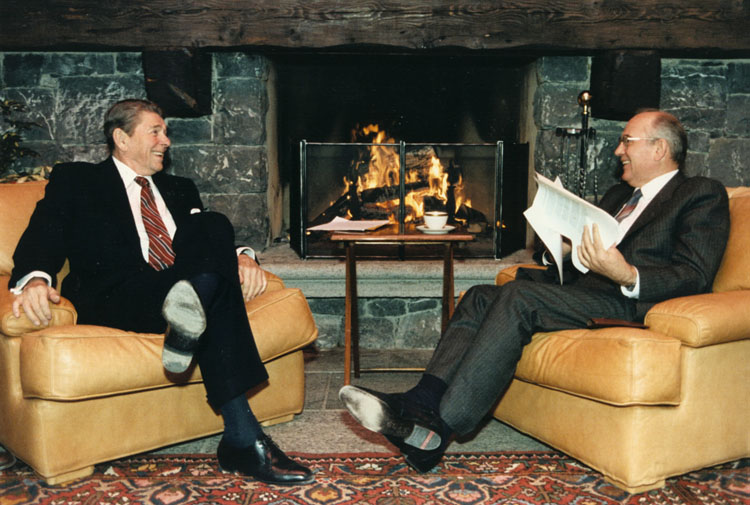
Reagan and Gorbachev at the
first Summit in Geneva, Switzerland - 19 November 1985
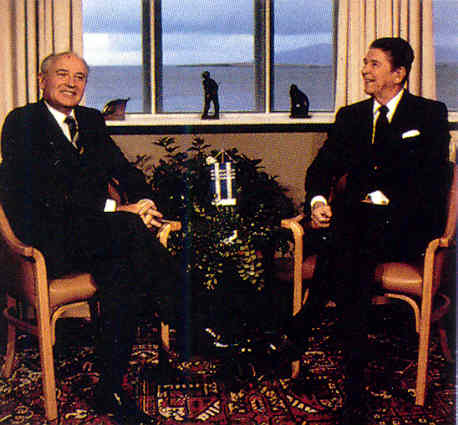
|
But for Reagan, this was not yet
enough. In June of 1987, as he stood before the Berlin Wall at the
Brandenburg Gate, Reagan uttered a challenge which would have a dramatic
impact on everyone: ...if you truly want peace and liberalization ... "Mr. Gorbachev, open this gate! Mr. Gorbachev, tear down this wall!" The gate did not open right away.
The wall was not torn down right away. But things were now headed
that way. In the last years of his administration, Reagan had become
a fond friend of Gorbachev – visiting back and forth between America and
Russia. Reagan truly wanted to support Gorbachev in his effort to
reform Russia.
But in the process Gorbachev had set loose in the Soviet Union a small opportunity for the revolution of rising expectations to take root in Russian society. Could he reform Russia without having it break down into chaos in the process? The answer would come soon enough. |
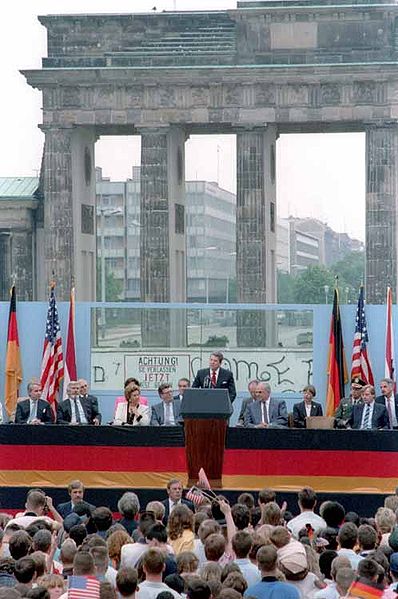
"Mr. Gorbachev, tear down this wall!" - June 1987
Gorbachev, realilzing that the Afghan War was merely weakening further the Soviet strategic position globally,
decides to call it quits in Afghanistan - July 1987
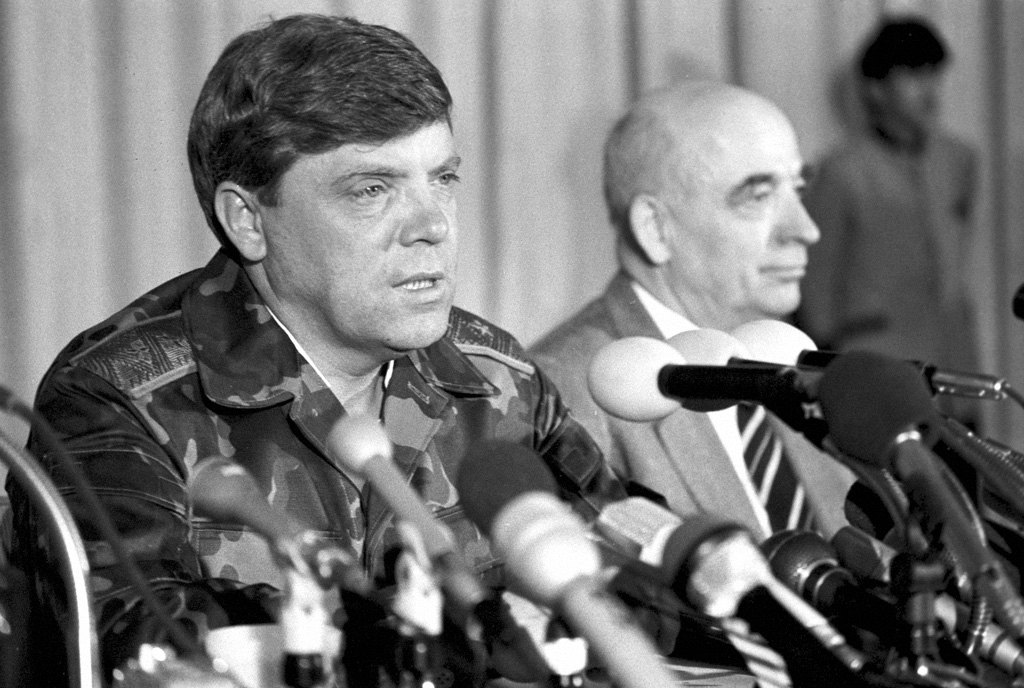
Soviet Commander Boris Gromov
announcing the Soviet troop pullout from Afghanistan - July
1987
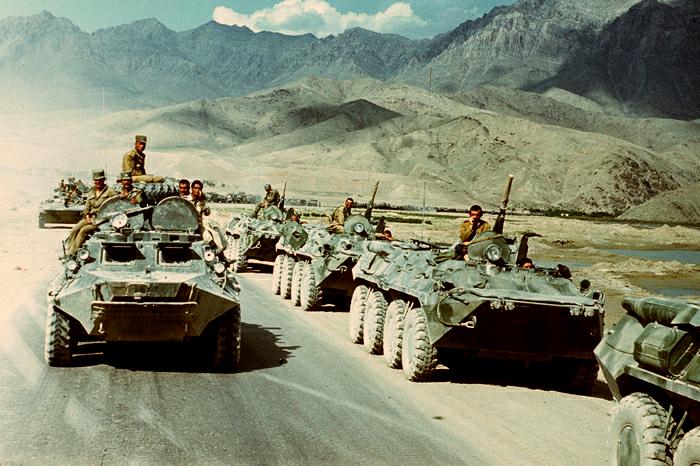
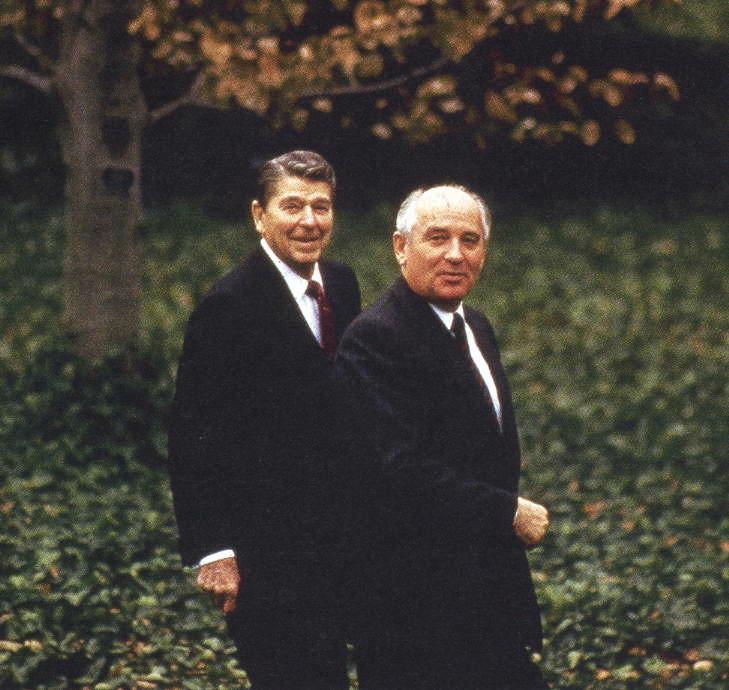
Gorbachev with Reagan on
a summit visit to Washington - 1987
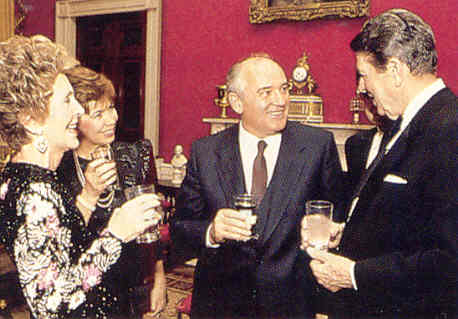
The Gorbachevs visit the
Reagans in Washington - December 1987
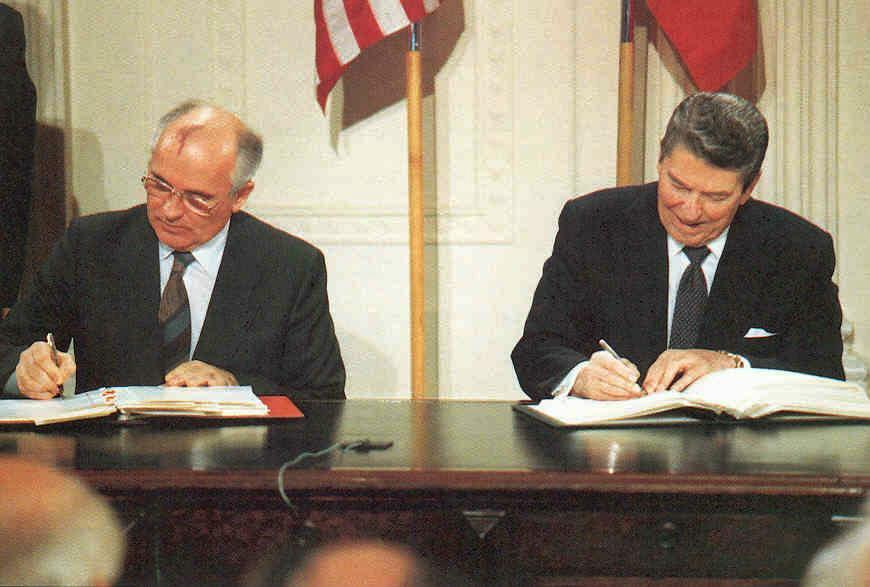
Gorbachev and Reagan sign
the Intermediate Nuclear Forces (INF) Treaty in Washington - 1987
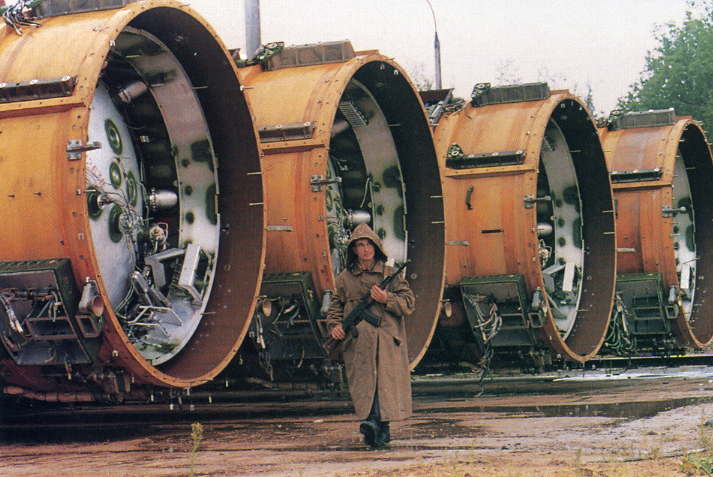
A Soviet sentry guarding
ICBMs scrapped under a 1987 disarmament treaty with the US
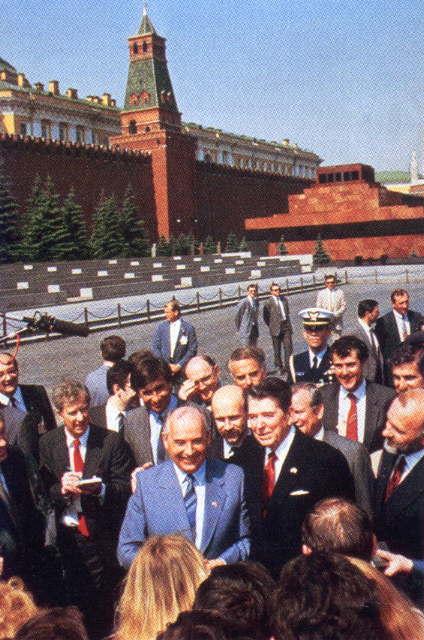
Gorbachev and Reagan in Moscow
- 1988
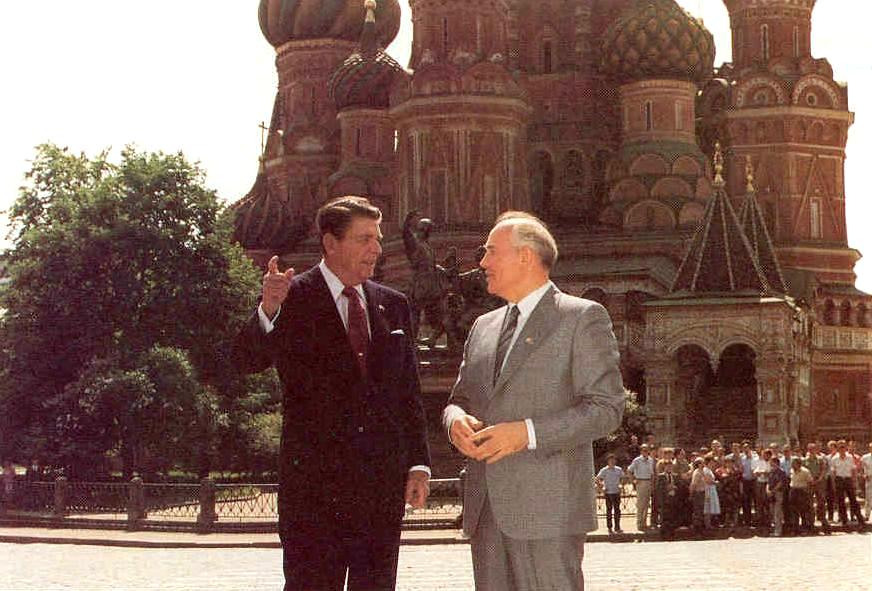
President Ronald Reagan visiting
with Soviet Premier Mickail Gorbachev in Moscow,
chatting in front of St.
Basil's Cathedral on Red Square
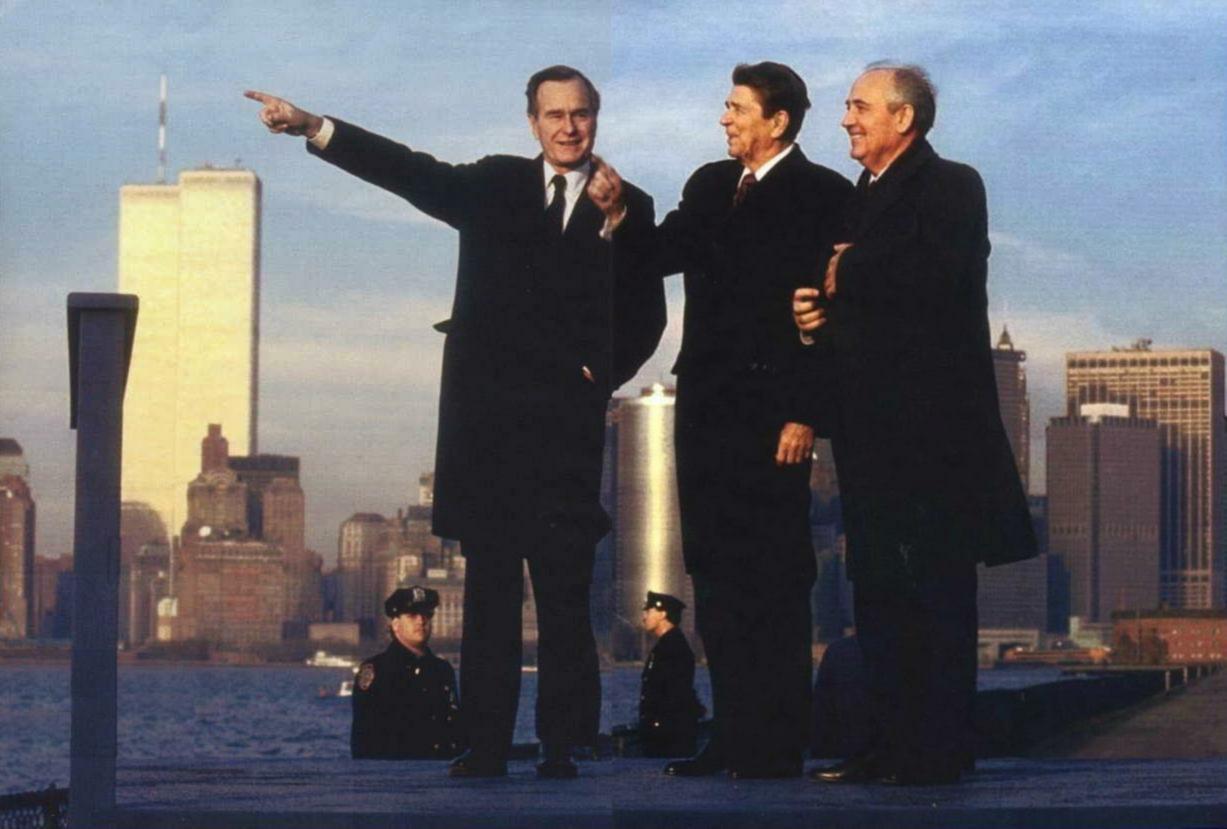
Soviet Premier Gorbachev
visiting Reagan and Bush in New York
shortly after the latter's
electoral victory in 1988
|
|
The break-up of the Soviet Empire in East Europe (1989) By 1989 the personal freedom and the reshaping of the Soviet government (including a newly elected parliament which had allowed different political parties to compete) that Gorbachev had allowed the Soviet people was transforming not only the Soviet Union but also the whole Soviet Empire in Eastern Europe. Poland. Poland had been edging away from Soviet domination since the creation in 1980 of the workers’ movement known as ‘Solidarity.’ Solidarity had been largely suppressed by the Polish military, fearful that Solidarity would bring on a punitive Russian reaction if left unchecked. But with Gorbachev’s liberalization of the Soviet Union, Solidarity had been allowed to compete openly in Poland – with the result that in elections in the summer of 1989 Solidarity swept the elections and in September formed the first non-Communist government inside the old Soviet bloc. This was the beginning of a mad dash of the rest of the Eastern European members of the Soviet bloc to also make their escape – one country after another voting non-Communist governments to power. East Germany. The most dramatic of all the turnovers was in East Germany – where the Communist leadership was subject to a widening protest movement. Germans began fleeing into a now free Hungary and Czechoslovakia into order to reach Austria or West Germany and long-sought freedom. Communist leader Honecker resigned in mid-October (1989) and the East German government started falling apart. Finally the Berlin wall was opened in early November to those desiring to leave East Germany - and the movement became a flood. Soon German youth took it upon themselves to start bashing away at the Wall. Romania. In Romania
the Communist government, seeing what was happening elsewhere, put up stiff
resistance to the reform movement. Communist dictator Ceausescu ordered
his security forces to fire on protesters - which prompted the military
to intervene in late December (1989) - but on the side of the protesters.
Ceausescu and his family were arrested and then quicky tried and executed.
This was the only part of the turnover in the Eastern Bloc that had proved
bloody. The Disintgration of the Soviet Union (1989-1991) This was the signal for the Soviet Union itself to begin to crumble. Gorbachev had hoped that by softening the hand of Communism he might reverse the apathy of his people to the Communist order and bring them back to its support. The minority Soviet Republics go their own way. But the response he received was instead for the many ethnic minority ‘republics’ to begin to press for the same freedoms recently received by the people in Eastern Europe. They wanted total national independence. The first to press the issue were the three Baltic states, Estonia, Latvia and Lithuania at various points in 1989. By the beginning of 1990 almost all the other minority republics – most importantly Ukraine – were demanding some form of national independence. The Communist Party itself was at this point no longer in tight control of the situation. The Gorbachev reforms had brought other groups into national politics in the newly created and empowered Soviet Parliament (the Congress of People’s Deputies), considerably weakening Gorbachev’s and the Communist Party’s hold over the political situation. Under Moscow’s mayor Yeltsin (who had abandoned his Communist label) even the huge Russian Federation was demanding independence. Gorbachev was rapidly losing control over a crumbling Soviet Union. The failed hard-liner coup. In August of 1991 angry Communist hardliners inside the Gorbachev cabinet moved to take matters in their own hands and clamp down on the reforms – and Gorbachev. For three days the plotters and their supporters secluded themselves in the Russian Parliament building - while opposition to them outside mounted, led by Moscow mayor Yeltsin. The coup collapsed and its leaders were arrested. Ultimately the coup succeeded only in stripping the last bit of authority away from Gorbachev and moving Yeltsin as the voice of the new ‘Russia’ into front and center position. Before the year was out all of the former Republics making up the Soviet Union – including Russia – had declared their independence. The Soviet Union was dead. |
|
|
Poland By 1989 the personal freedom and the reshaping of the Soviet government (including a newly elected parliament which had allowed different political parties to compete) that Gorbachev had allowed the Soviet people was transforming not only the Soviet Union but also the whole Soviet Empire in Eastern Europe. Poland had been edging away from Soviet domination since the creation in 1980 of the workers’ movement known as ‘Solidarity.’ Solidarity had been largely suppressed by the Polish military, fearful that Solidarity would bring on a punitive Russian reaction if left unchecked. But with
Gorbachev’s liberalization
of the Soviet Union, and as a result of a Polish Round Table Conference
(February-April 1989) between Polish Communist authorities and Solidarity,
Solidarity was allowed to compete openly in Poland – with the result that
in elections in the summer of 1989 Solidarity swept the elections and in
September formed the first non-Communist government inside the old Soviet
bloc. This was the beginning of a mad dash of the rest of the Eastern
European members of the Soviet bloc to also make their escape – one country
after another voting non-Communist governments to power. Hungary Reform had already begun in 1988 in Hungary when Communist dictator János Kádár resigned as Communist Party chief and the Hungarian Parliament adopted a number of reforms to offer Hungarian society greater freedom. During the summer (actually April-September) of 1989 Hungary followed the Polish example and undertook even wider reforms with its own 'Round Table' meetings. In May the 120-mile border fence with Austria was taken down - ending the 'imprisonment' of the Hungarians under Communism. Then in October the Hungarian Communist Party disolved itself, or reconstitted itself as the Hungarian Socialist Party, in anticipation of new multi-party elections and a direct election of the country's president (scheduled for the following May). Hungary even renamed itself simply the Hungarian Republic (instead of the Communist phraseology of "Hungarian People's Republic") |
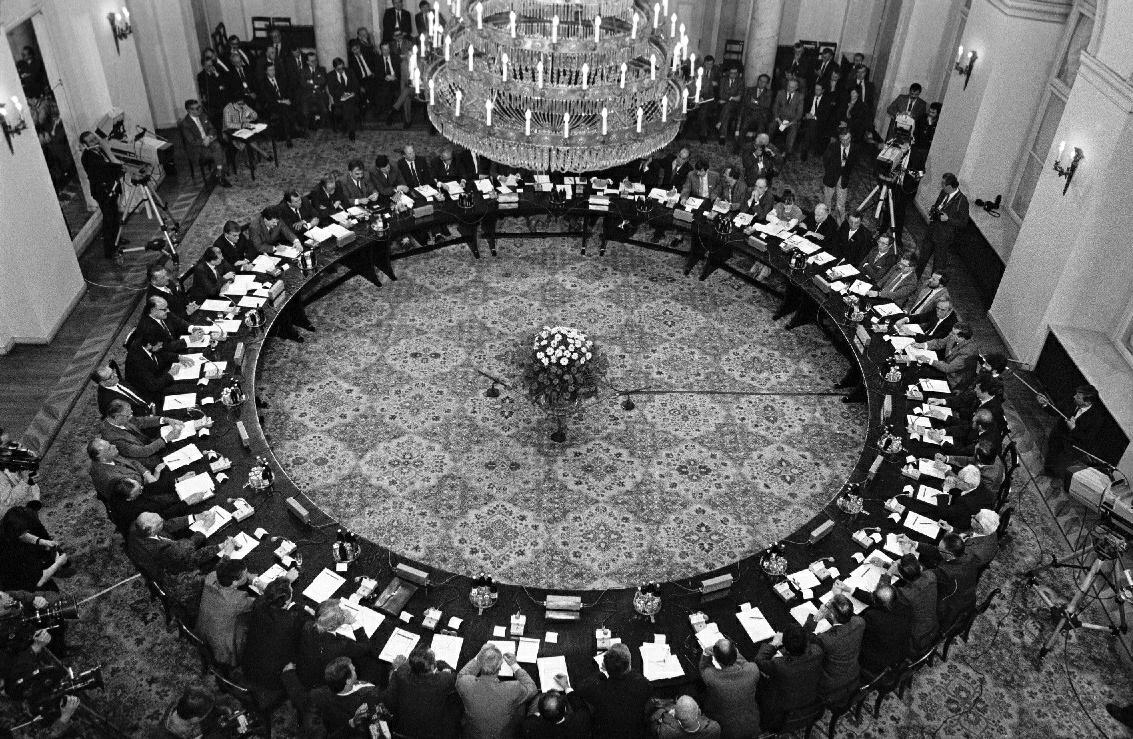
Polish Round Table Talks
took place in Warsaw, Poland from February 6 to April 4, 1989
beginning the challenge
of the East European 'Soviet satellite' countries to Communist domination
|
East Germany The most dramatic of all the turnovers was in East Germany – where the Communist leadership was subject to a widening protest movement. Germans began fleeing into a now free Hungary into order to reach Austria or West Germany and long-sought freedom. Communist leader Honecker resigned in mid-October (1989) and the East German government started falling apart. Finally the Berlin wall was opened in early November to those desiring to leave East Germany - and the movement became a flood. Soon German youth took it upon themselves to start bashing away at the Wall. |
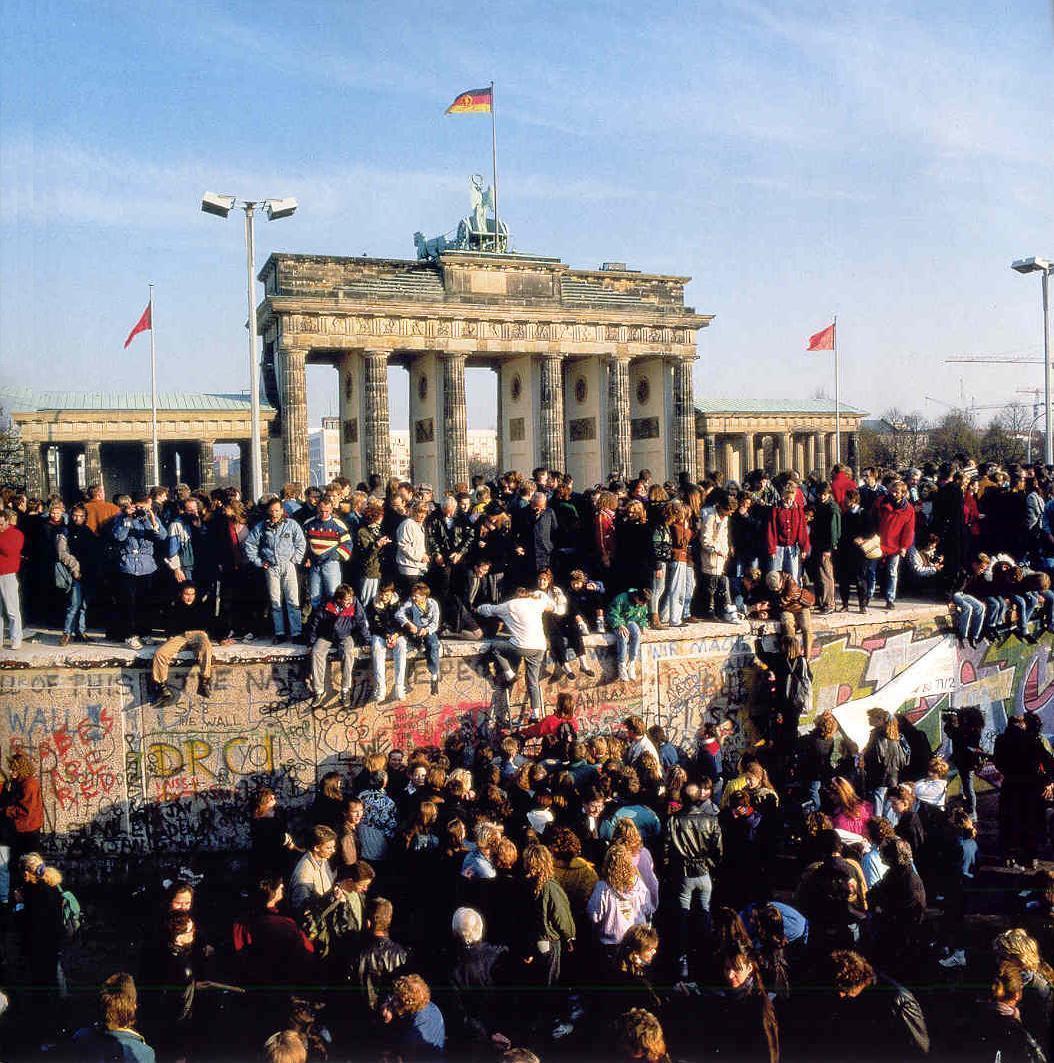
Celebrating the collapse
of East German Communism atop the Berlin Wall - November 10, 1989
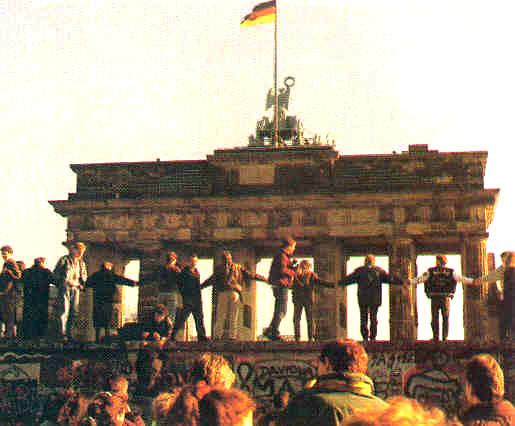
Germans dancing atop the
Berlin Wall
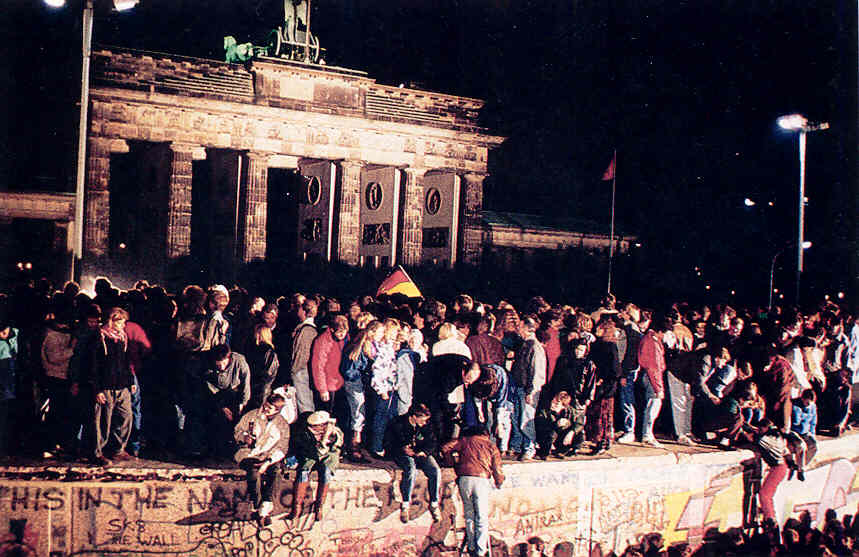
East and West Berliners celebrating
the end of 28 years of separation by the Berlin Wall - November 10, 1989.
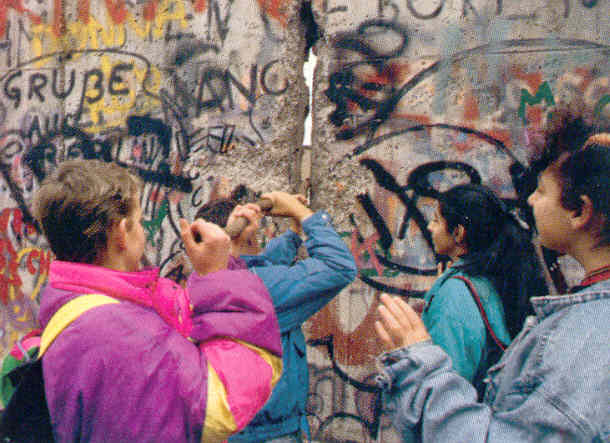
Hammering down the Berlin
Wall
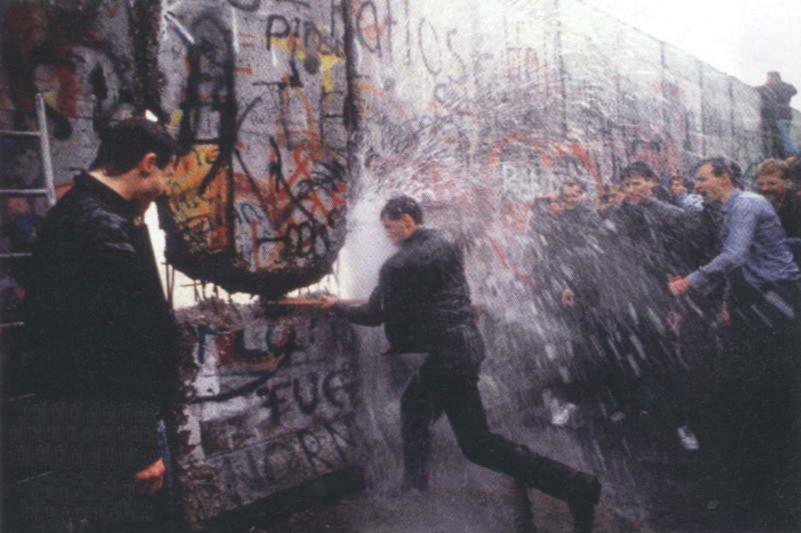
Bashing the Berlin Wall -
1989

Picking apart the Berlin
wall
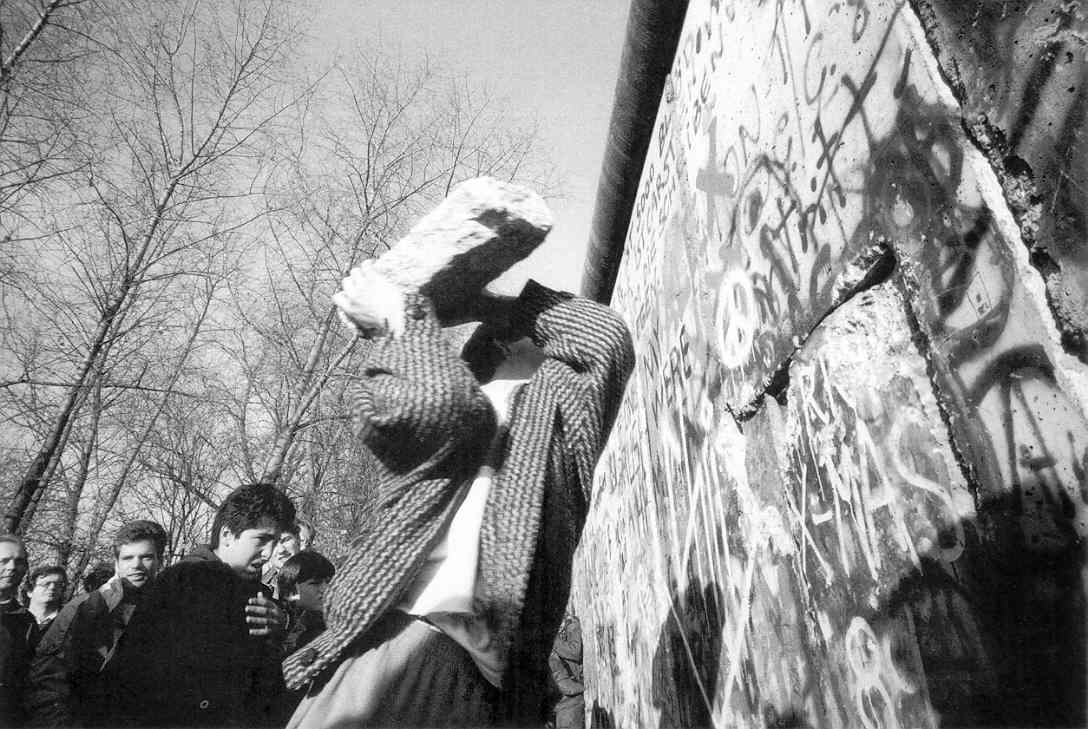
Germans chipping away at the Berlin Wall
|
Czechoslovakia - The "Velvet Revolution" Inspired by changes in Poland, Hungary and East Germany, the Czechoslovaks soon began to agitate for such reforms to their own Communist-controlled government and society. Students, encouraged by Czech dissident Vaclav Havel, played a huge role when they gathered in Prague and elsewhere in ever-increasing numbers in the second half of November, to protest against Communist authority. Actors and artists joined the students on strike and theaters were opened only to conduct spontaneous 'round table' discussions. Toward the end of the month the entire Communist Presidium resigned in order to make way for a more 'moderate' Communist leadership. But the demonstrations merely grew more extensive,with a 2-hour general strike supported by an estimated 75% of the population finally convincing the Czech Communists that their days were over. A non-Communist government was formed (early December) and free elections scheduled for the end of December (won handily by Vaclav Havel). |
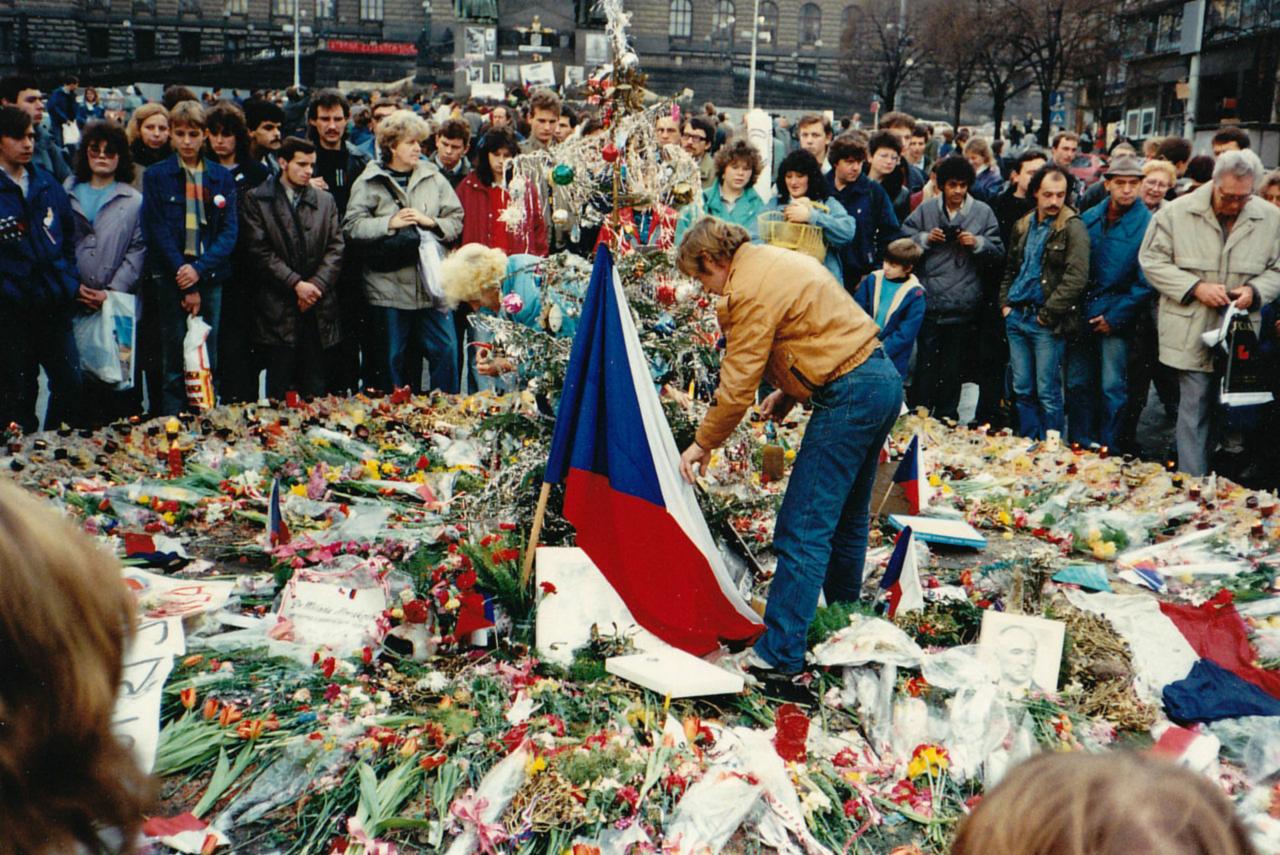
Vaclav Havel & peaceful Prague protest - November 1989
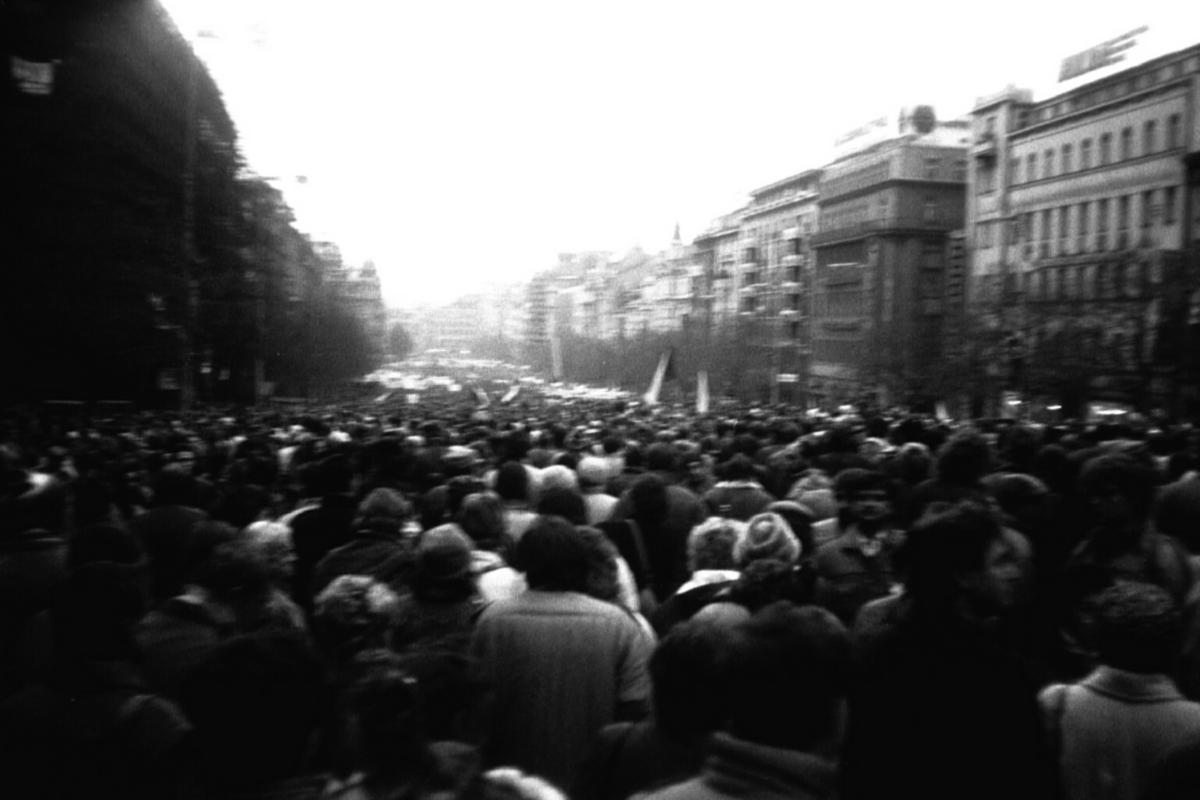
Wenceslas Square during the
Velvet Revolution - November 1989
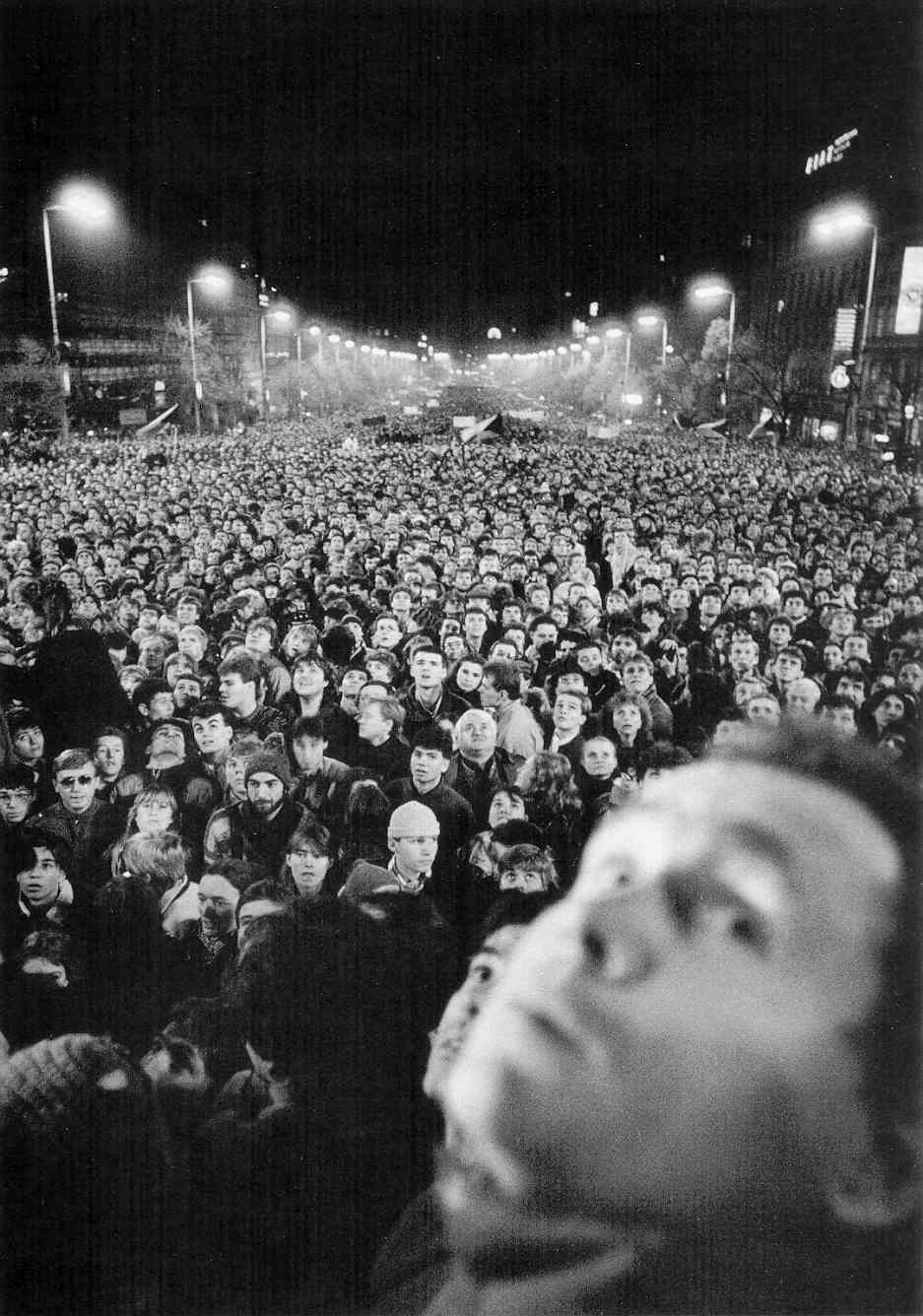
A pro-reform rally in Wencelas
Square in Prague - November 1989.
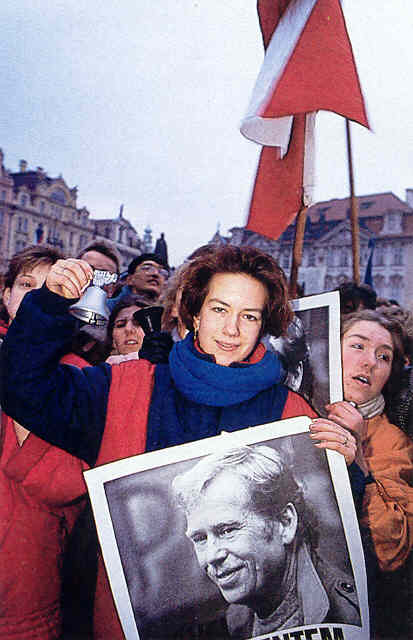
Czechs in Prague celebrating their new freedoms ... won under the leadership of Vaclav Havel - January 1990
|
Romania In Romania the Communist government, seeing what was happening elsewhere, put up stiff resistance to the reform movement. Communist dictator Ceausescu ordered his security forces to fire on protesters - which prompted the military to intervene in late December (1989) - but on the side of the protesters. Ceausescu and his family were arrested and then quicky tried and executed ... ending the 25-year rule of one of the harshest of the East European Communist leaders (he was considered something of an on-going 'Stalinist'). This was the only part of the turnover in the Eastern Bloc that had proved bloody. |
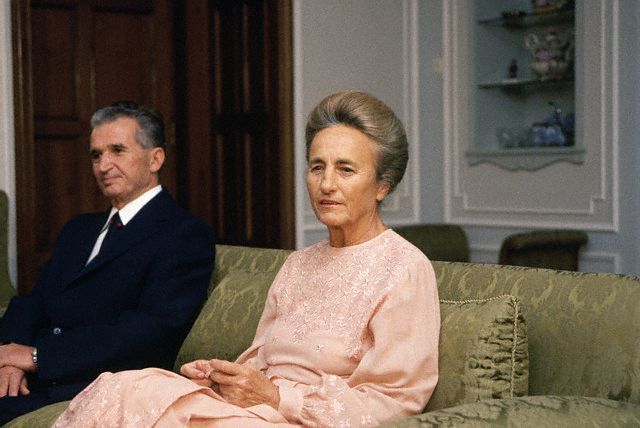
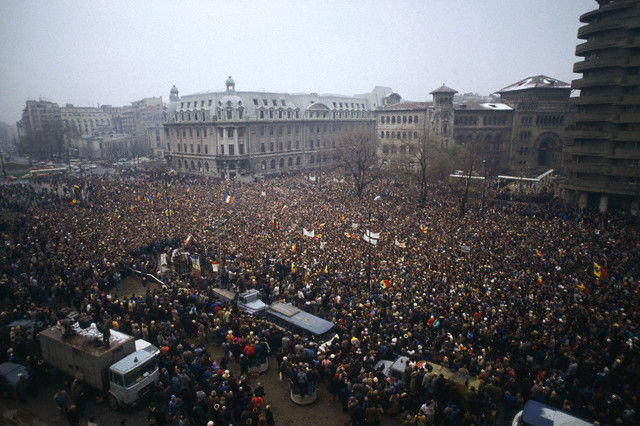
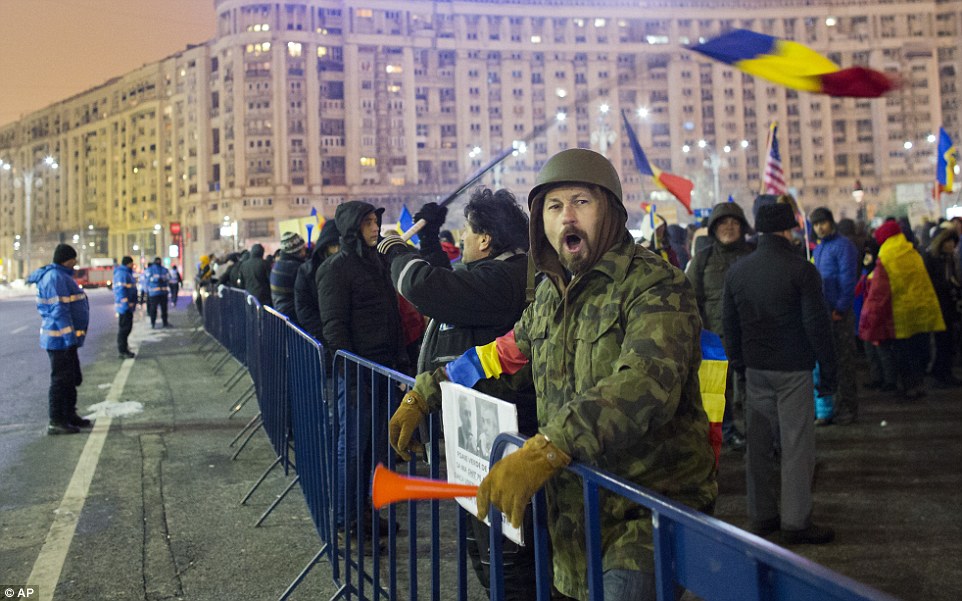
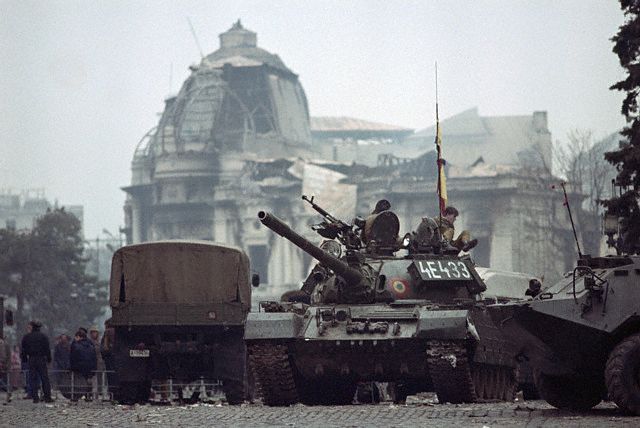
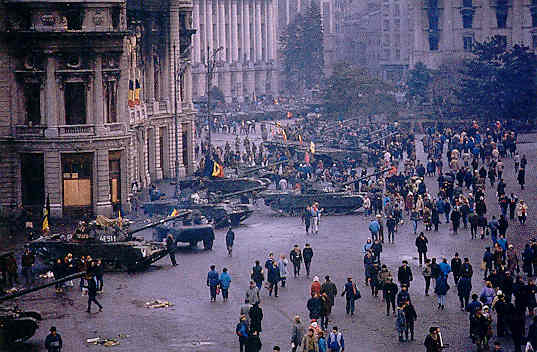
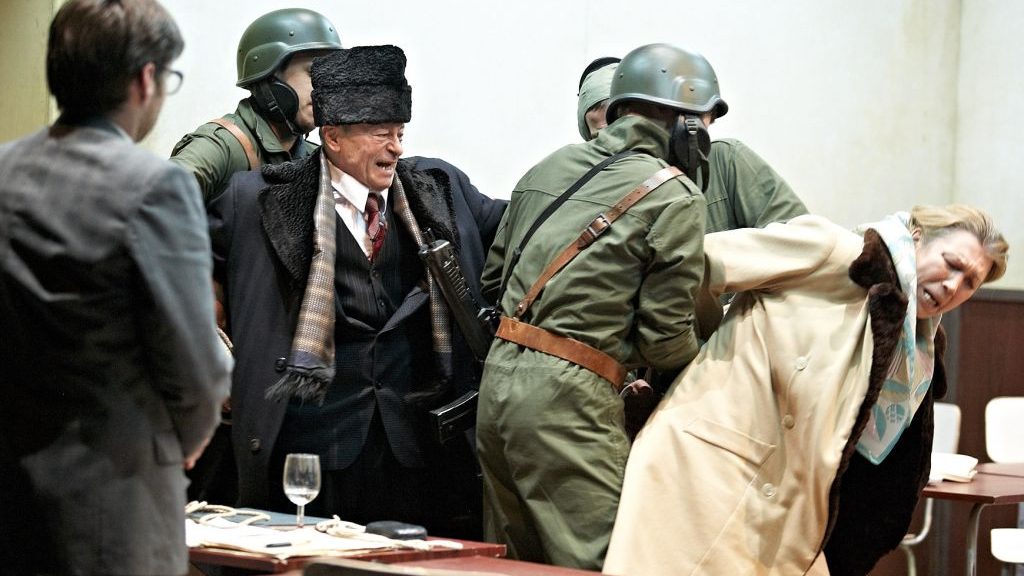
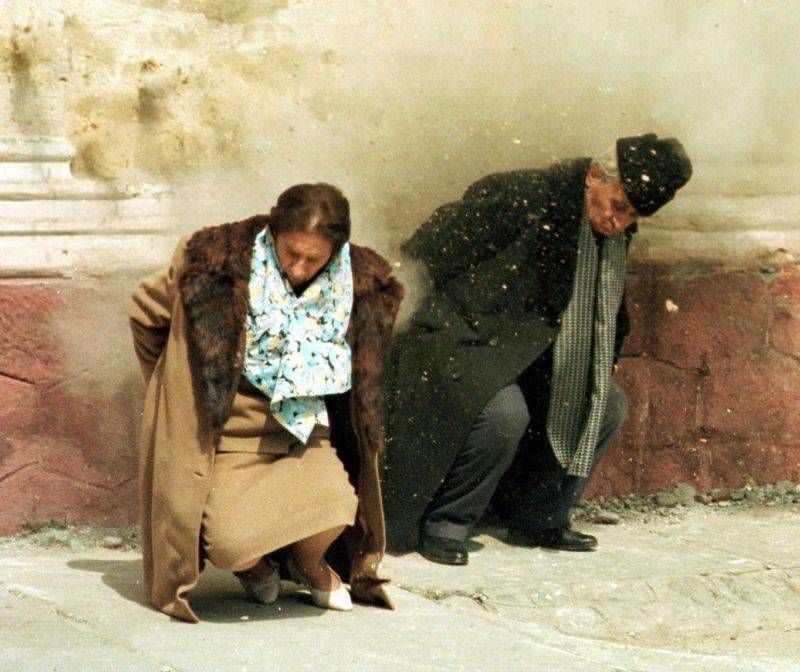
|
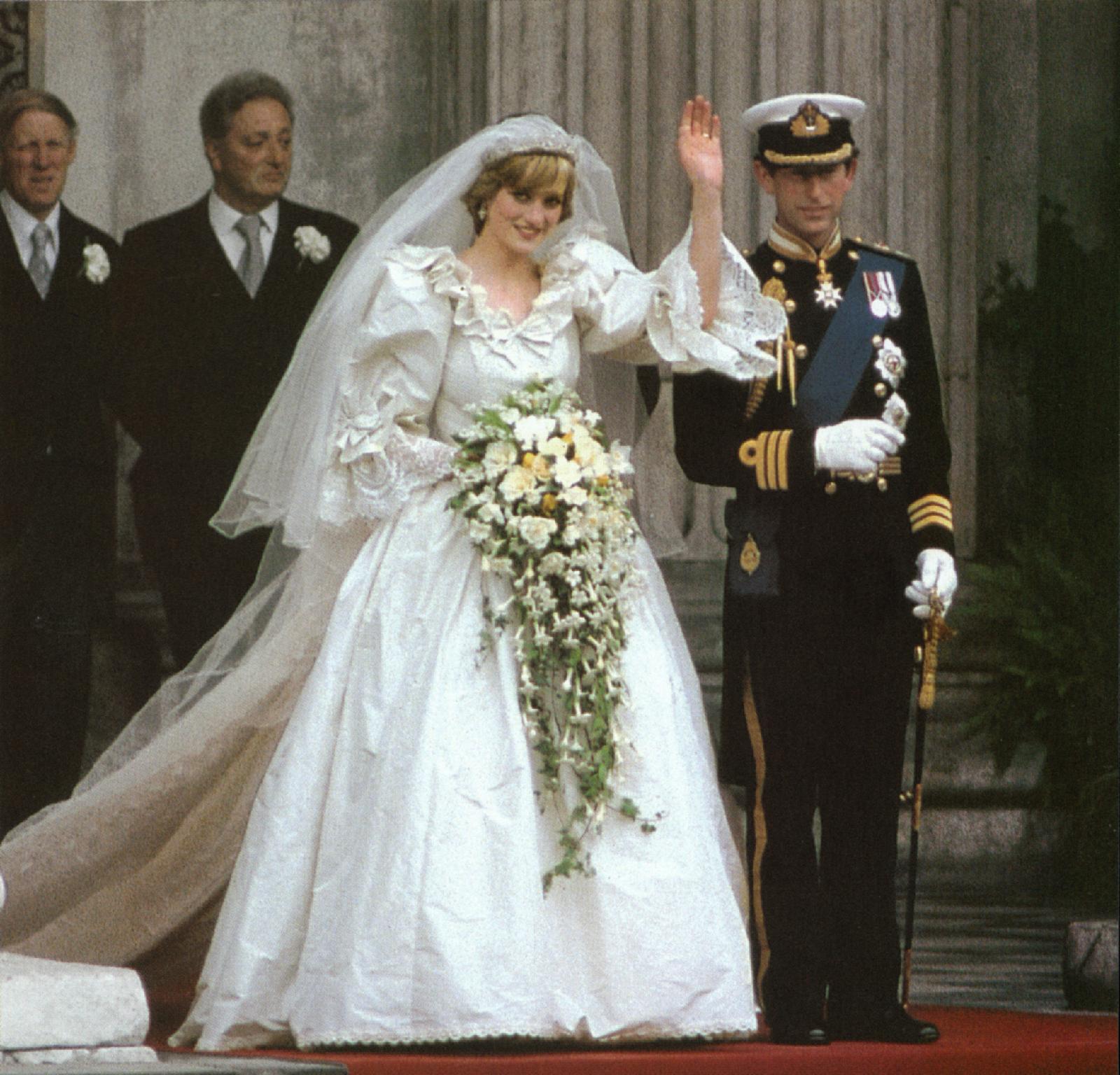
Prince Charles and Lady Diana
Spencer wed - July 29, 1981
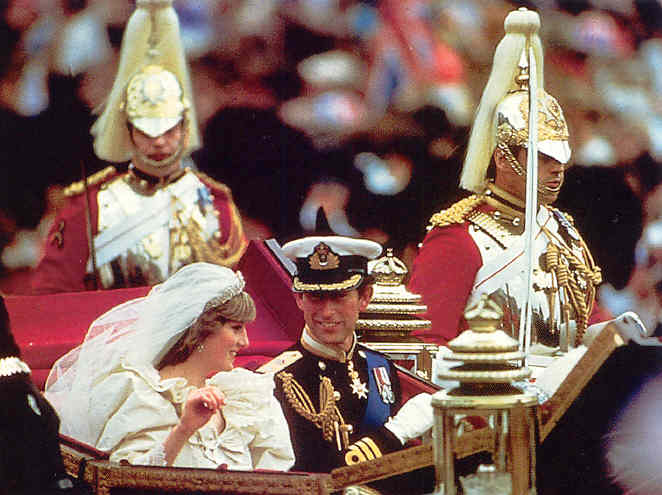
The Wedding of Diana and
Charles - 1981
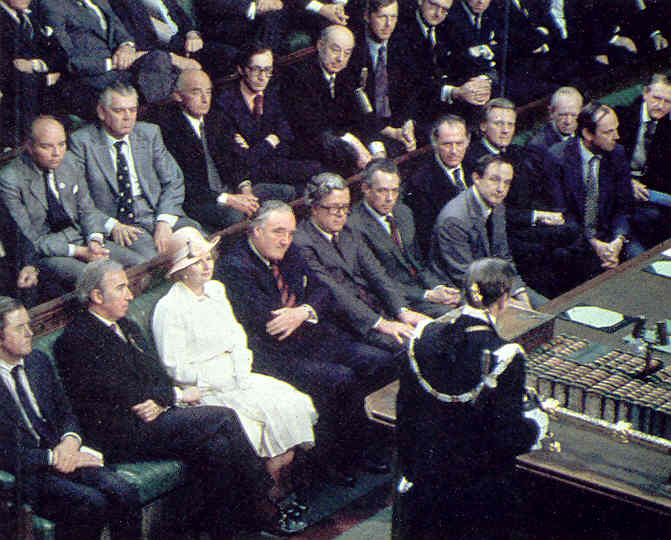
Margaret Thatcher and the Conservative Party Leadership in Parliament
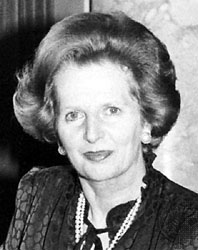
The 1980s mark a period of
very close relations between England and America
thanks to the deep friendship
that developed between Thatcher and Reagan
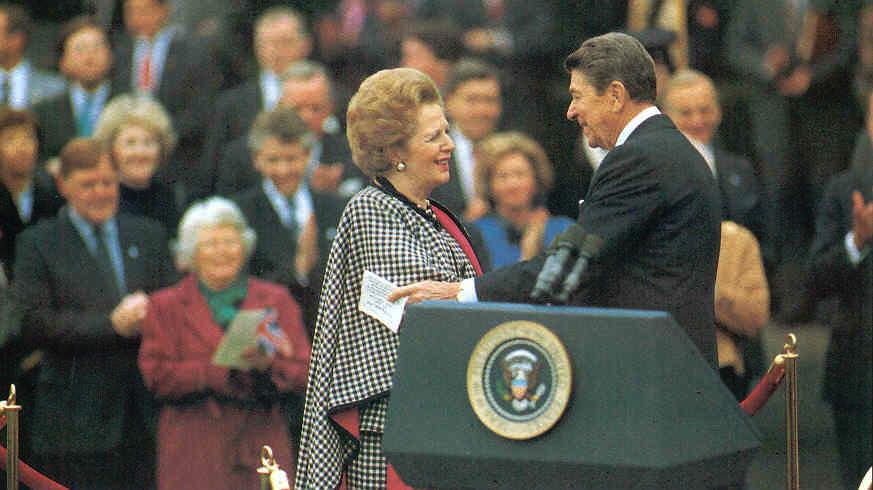
Ronald Reagan greets Margaret
Thatcher on a visit to the United States in 1983
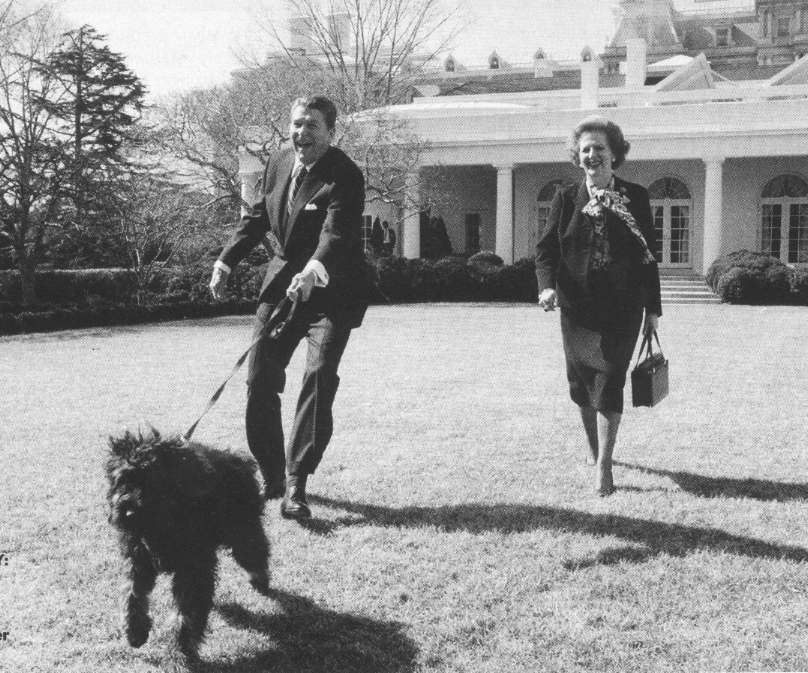
Margaret Thatcher with Reagan on a visit to Washington
Western Europe moves forward to a closer political union
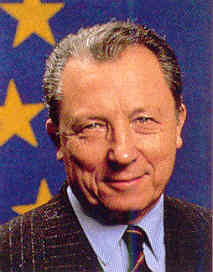
French diplomat Jacques Delors,
head of the European Community Commission - 1985
(he presided over the signing
of the drafting of the Single European Act
which called for full integration
of the 12-member community)
|

Assassination attempt of
the Pope by a Turkish gunman - May 13, 1981
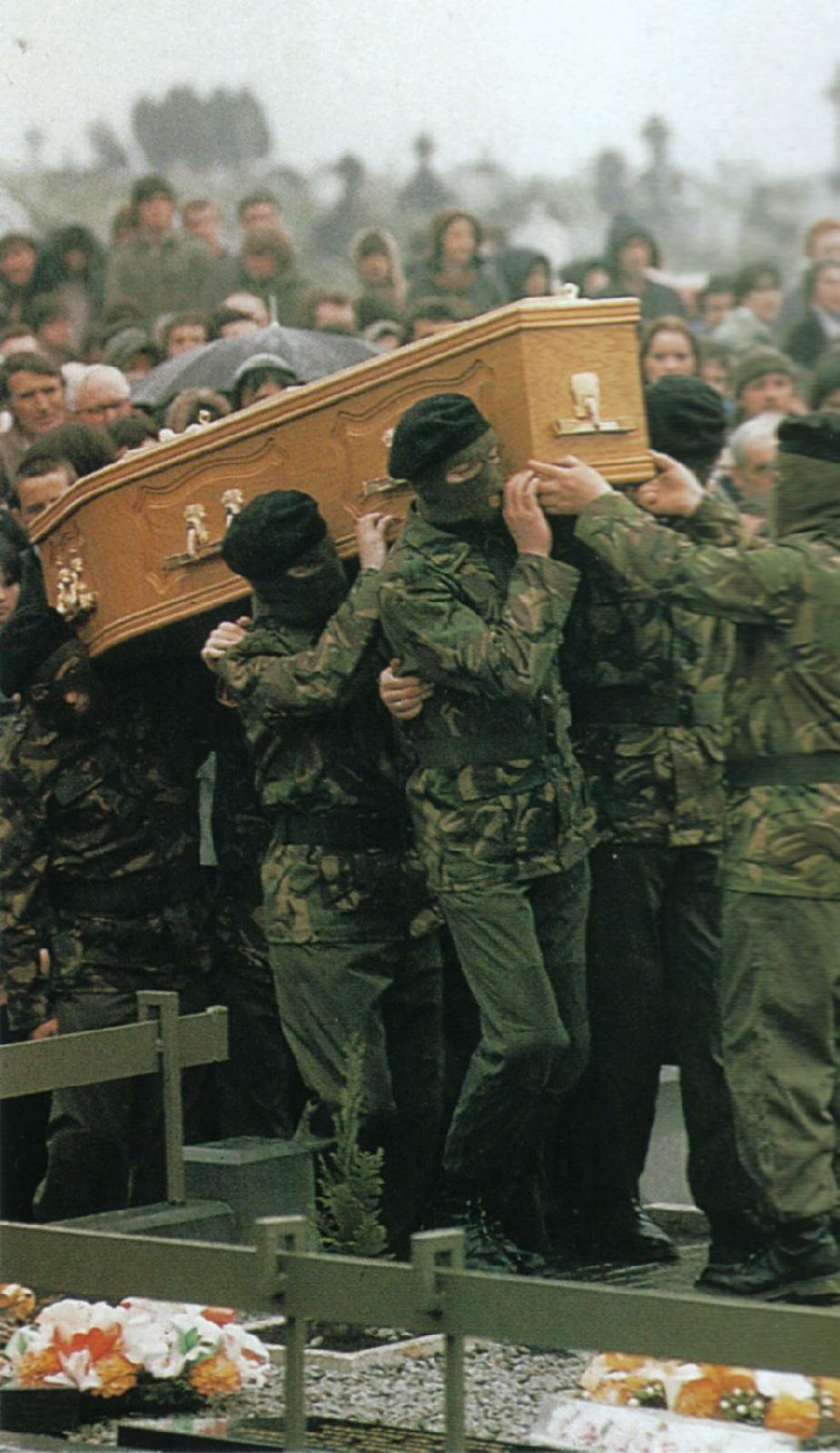
IRA member Bobby Sands funeral
- Belfast - 1981
(He fasted to death in protest against
English 'occupation' of Northern Ireland.
Nine others followed his example.
But this dramatic demonstration failed to move English PM Thatcher)
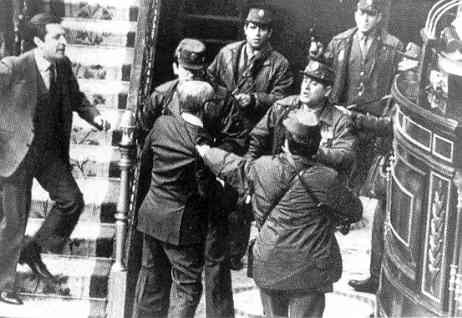
Members of the Guardia Civil
burst into Spain's Parliament in an attempted military coup - February
23, 1981
The Italian government takes on the Mafia
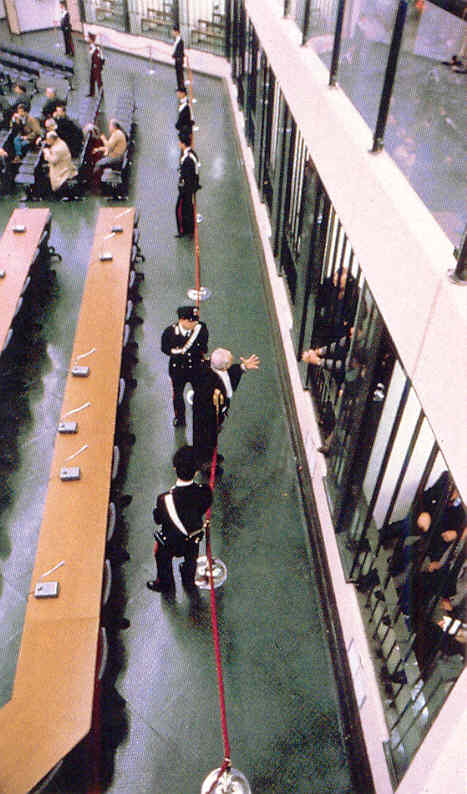
|
But serious problems begin
to develop in the late spring of 1989 --
as Chinese students demand some of the same reforms
that they see Communism
undergoing in Eastern Europe
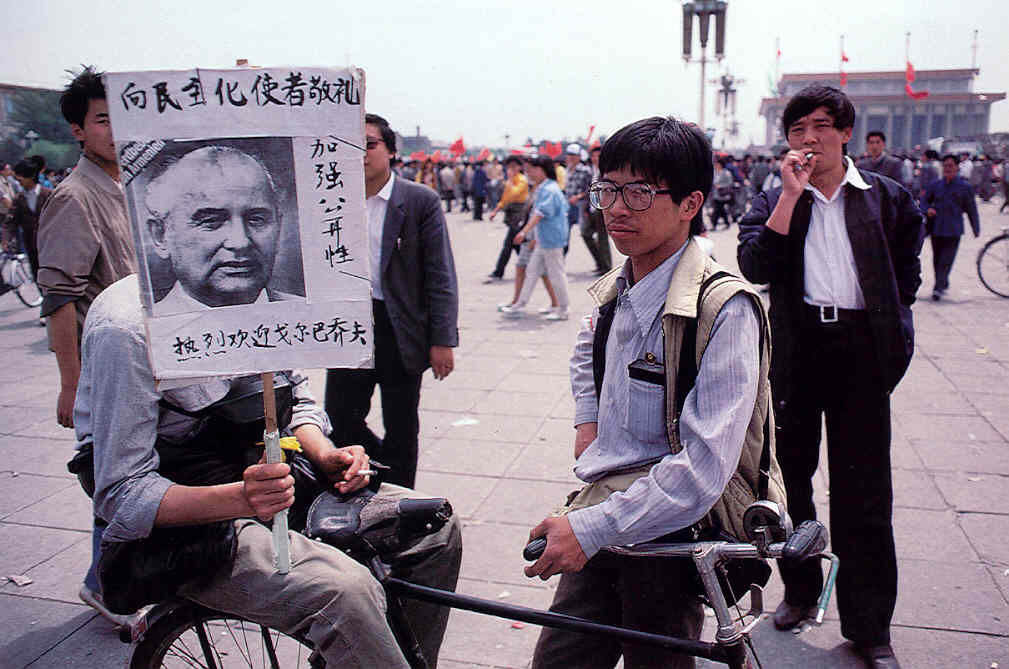
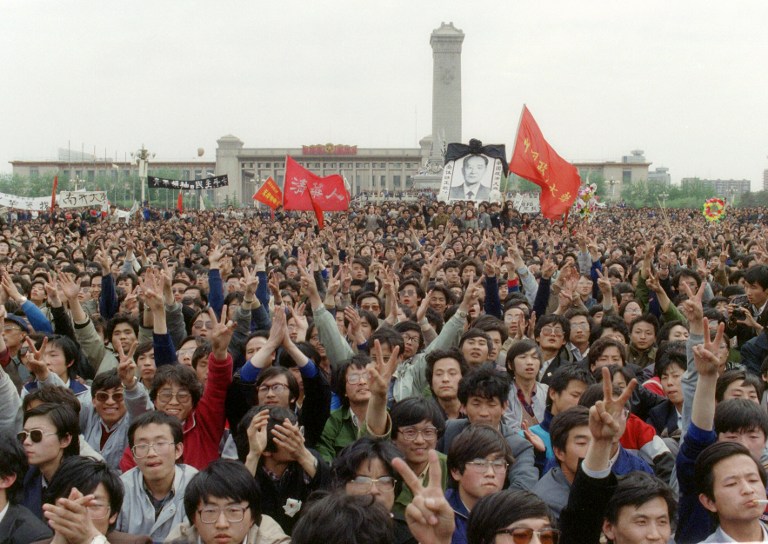
April 22, 1989 - thousands (200,000?) of students at Tiananmen Square gather to honor Liberal reformer Hu Yaobang
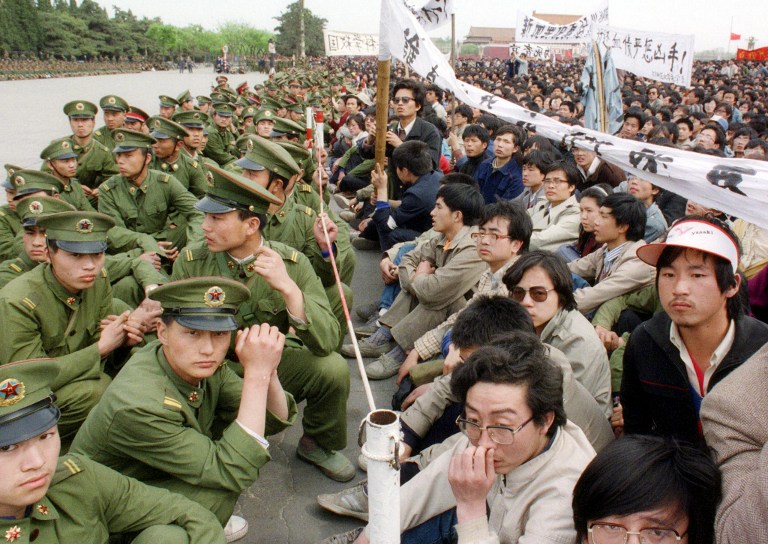
Police and protesters meet at a line drawn up in front of the Great Hall of the People
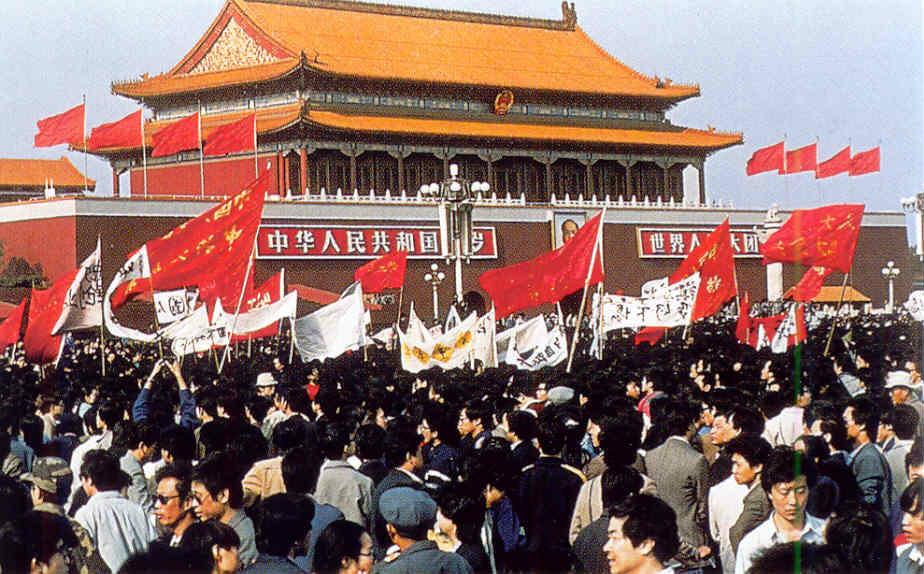
Student demonstraters gather in ever greater numbers in Tiananmen Square, Beijing - April 27, 1989
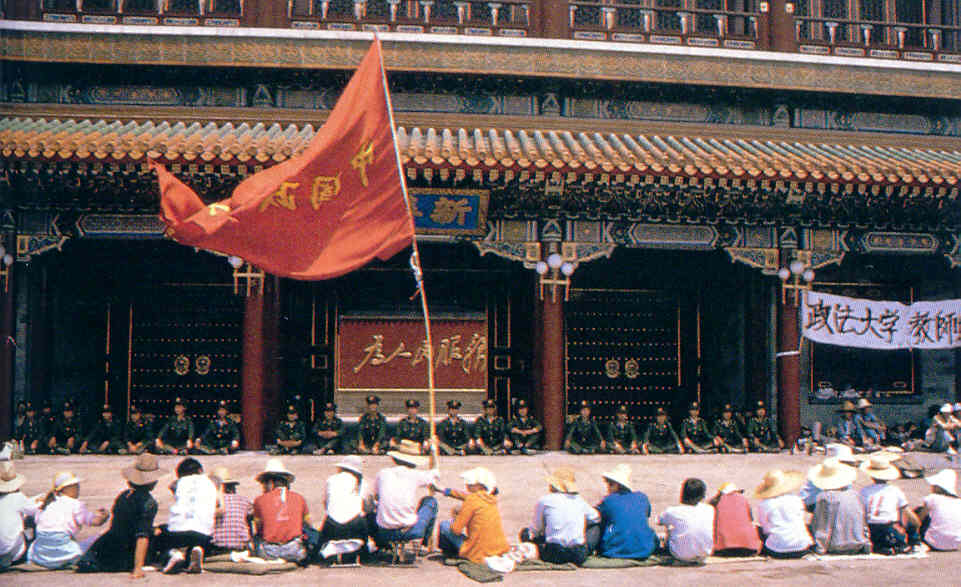
Students in Tiananmen Square
in silent protest before the Red Army - late spring 1989.
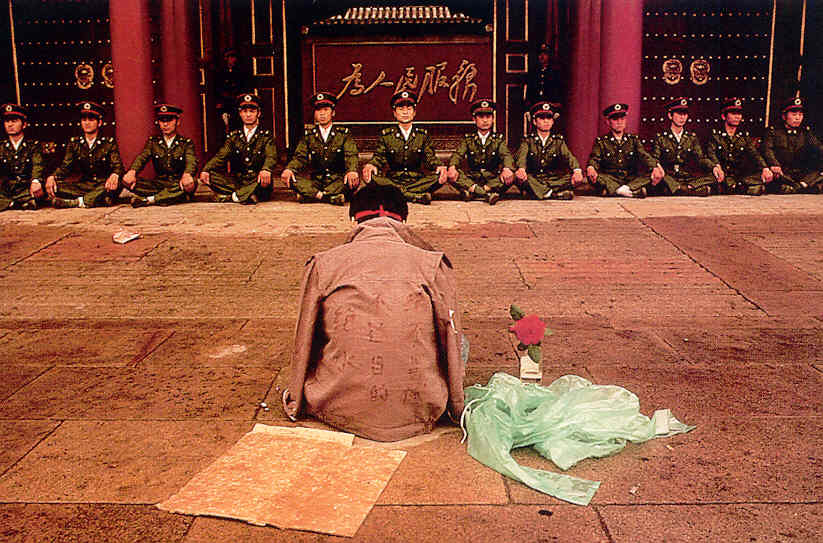
A student protester seated before the Chinese military - May 1989.
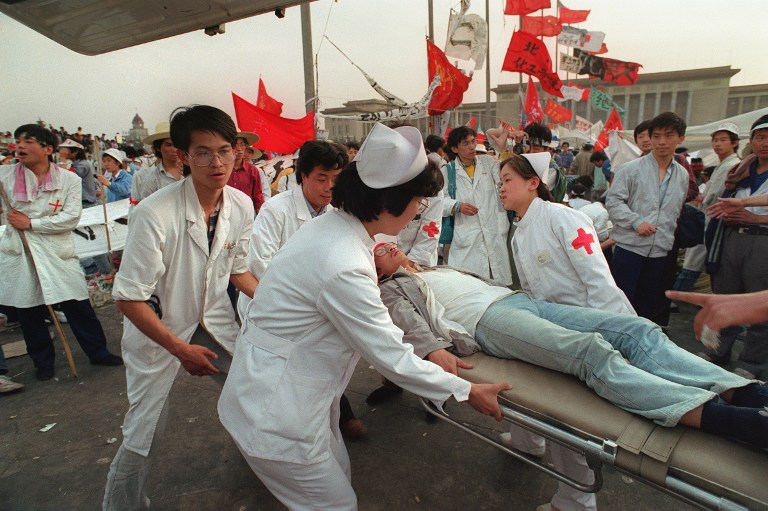
In mid-May a number of the students undertook a hunger-strike to protest in favor of democracy
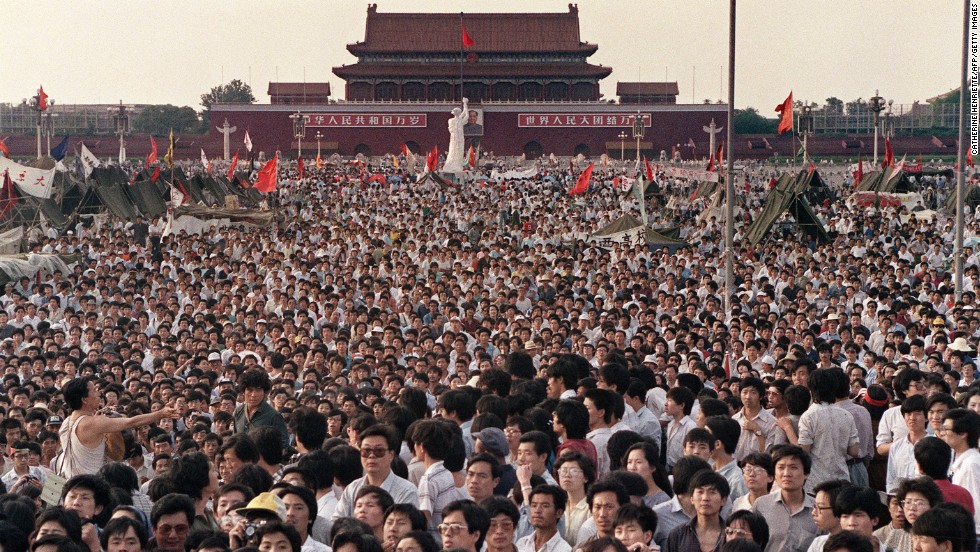
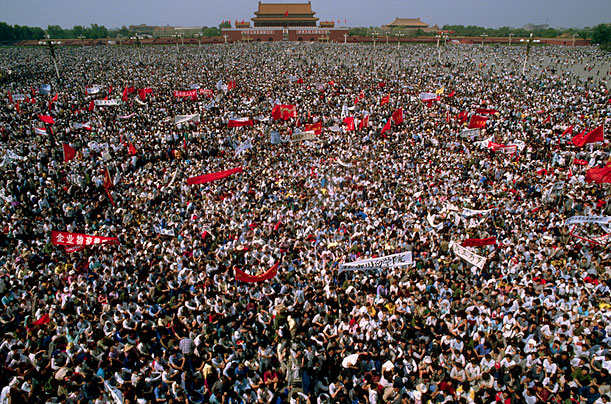
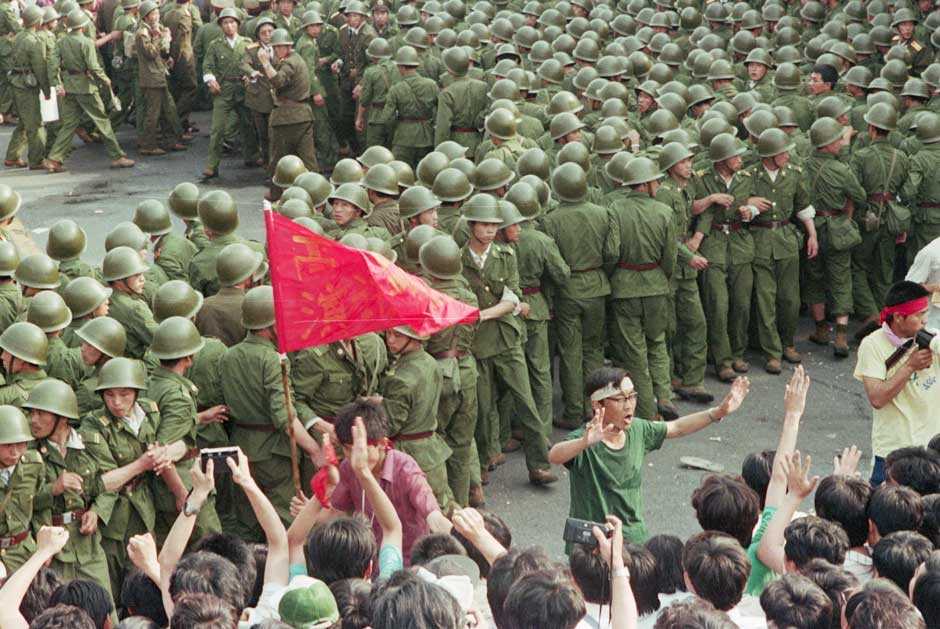
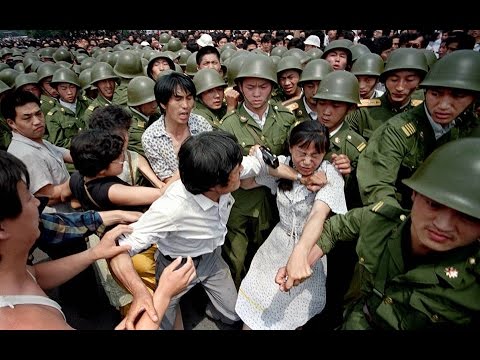
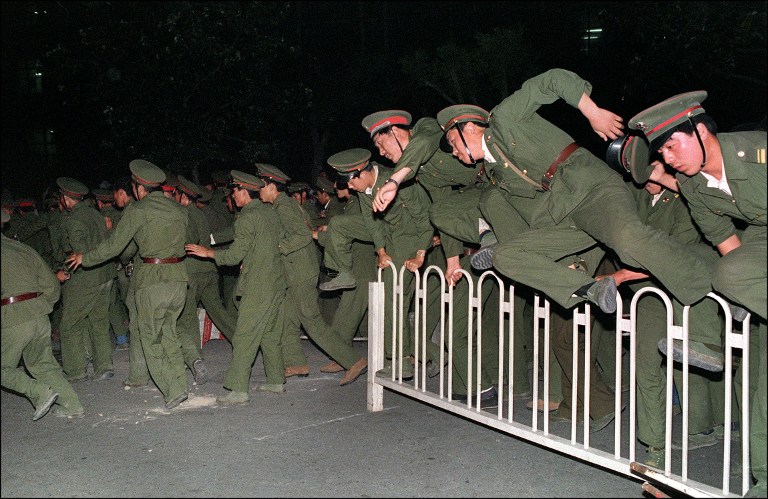
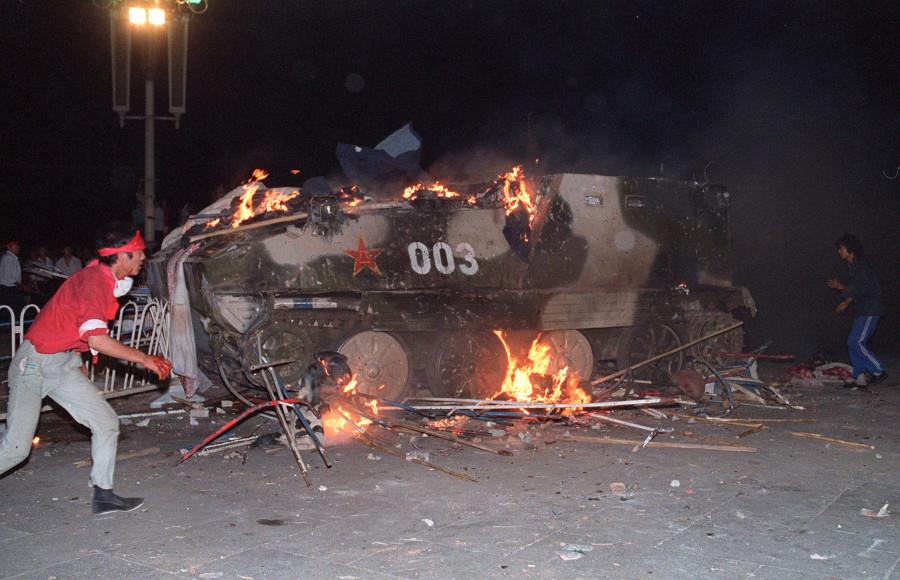
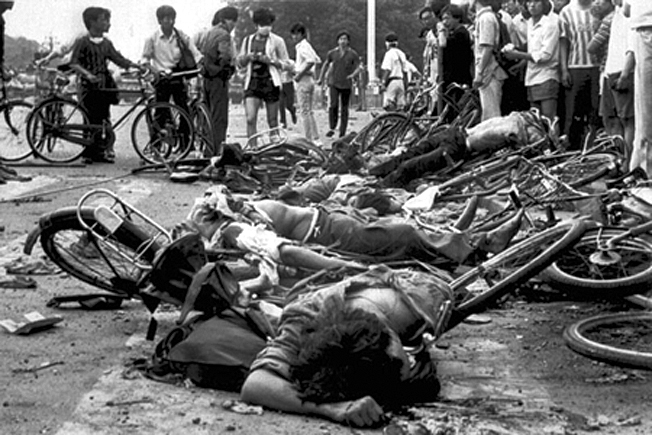
The aftermath of the Tiananmen Square
protest
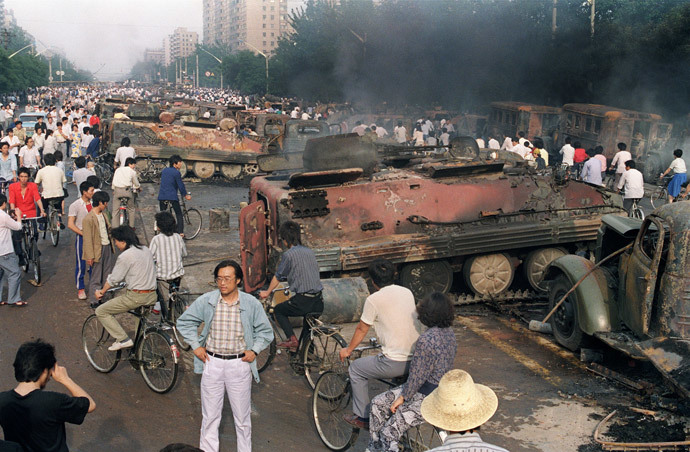
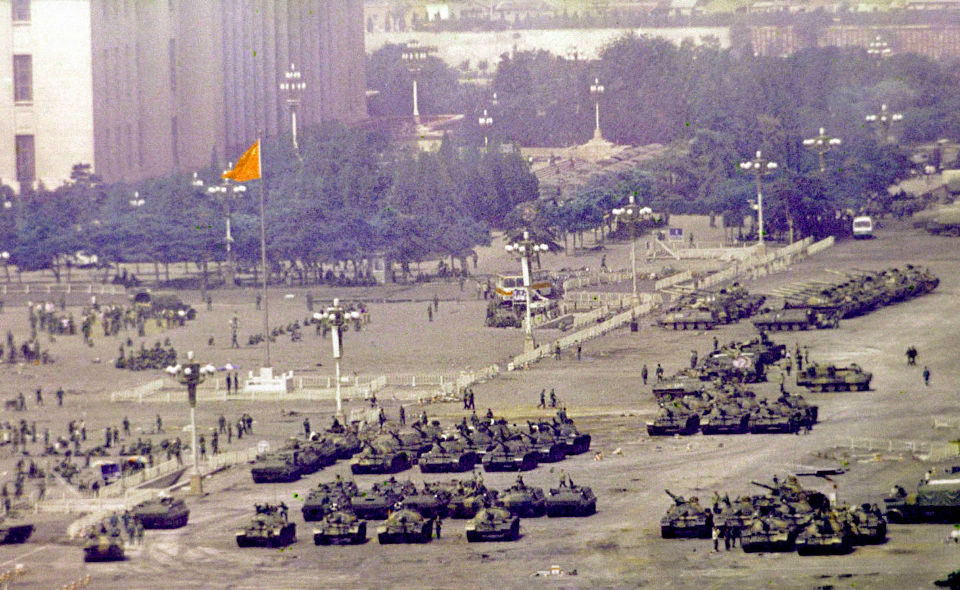
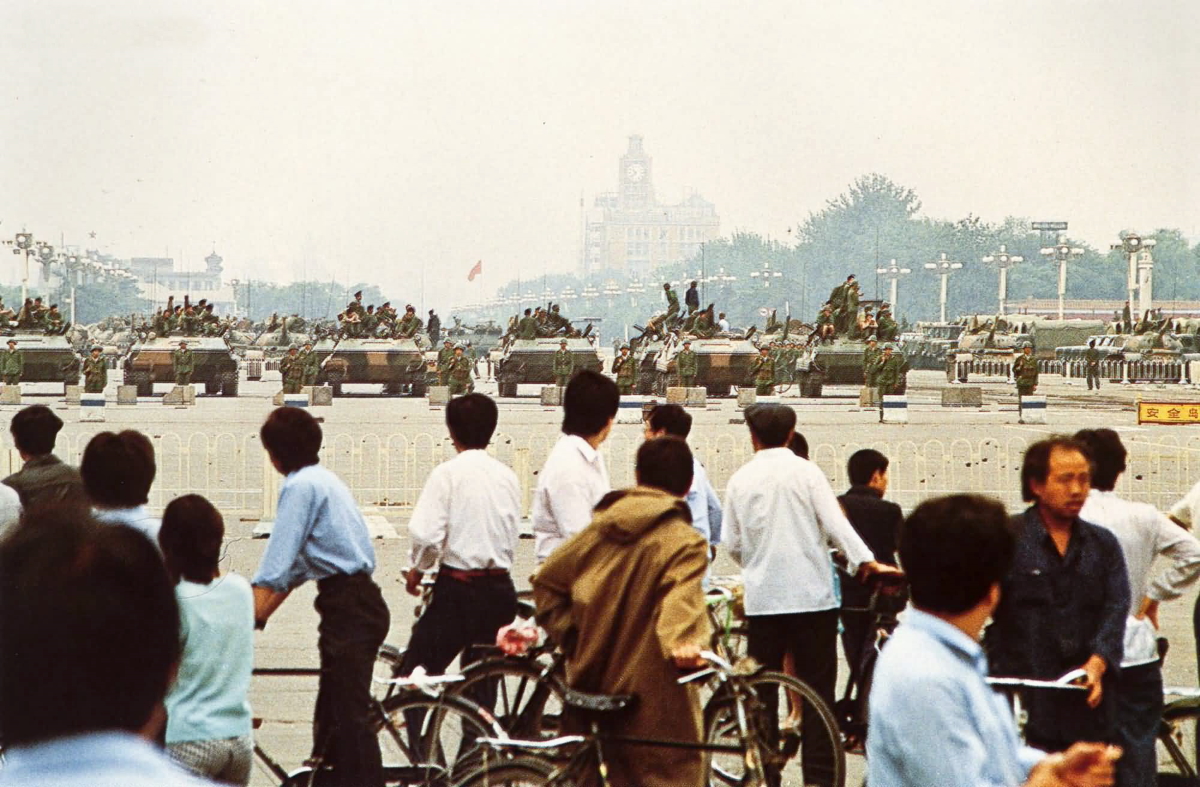
Tanks advancing on the remaining protesters
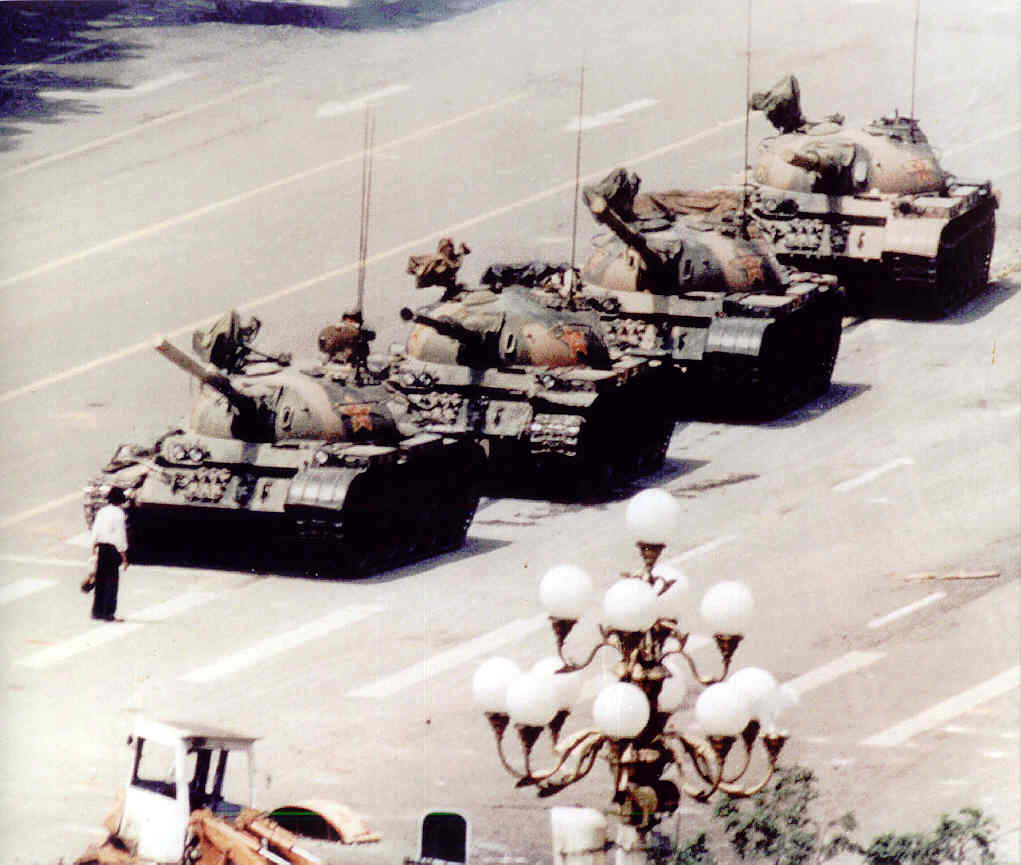
A student defying Chinese
T-59 tanks in Tiananmen Square - June 5, 1989
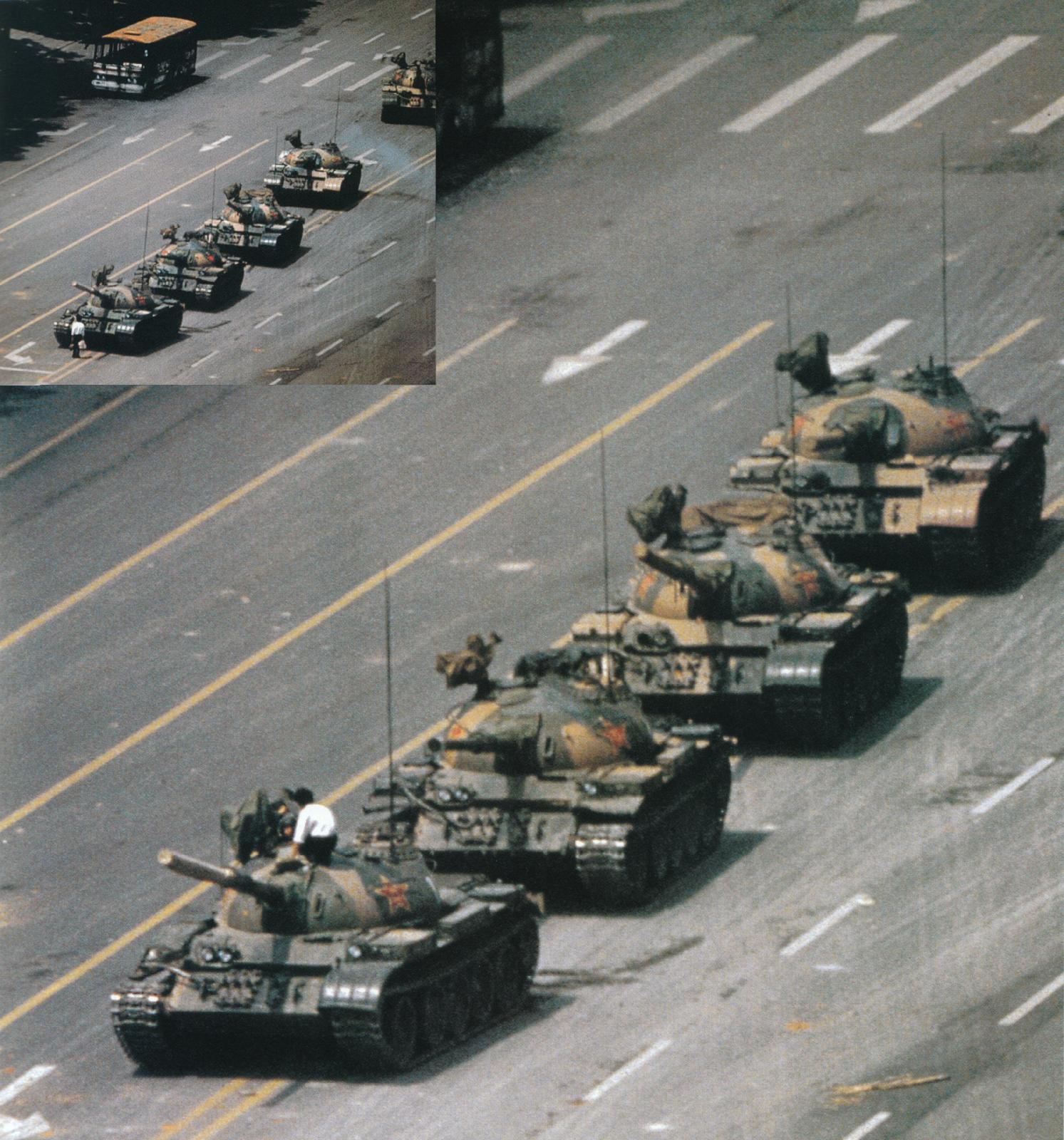
A lone protester and Chinese T-59 tanks at Tiananmen Square - 1989
|
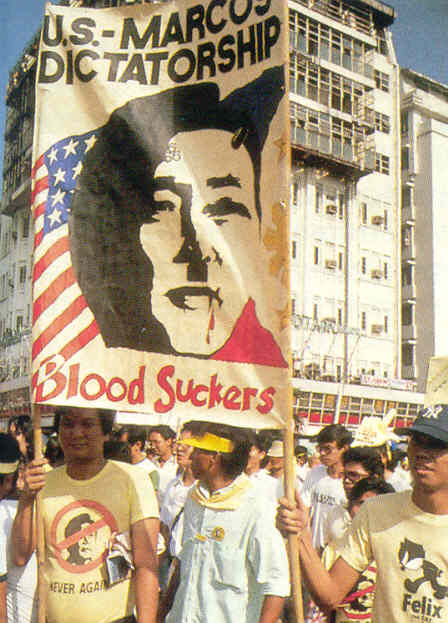
Anti-Marcos demonstrations
in Manila - 1986
(He was finally deposed
following a very fraudulent election in February 1986
when some of the military
backed a popular uprising by pro-Aquino Filipinos)
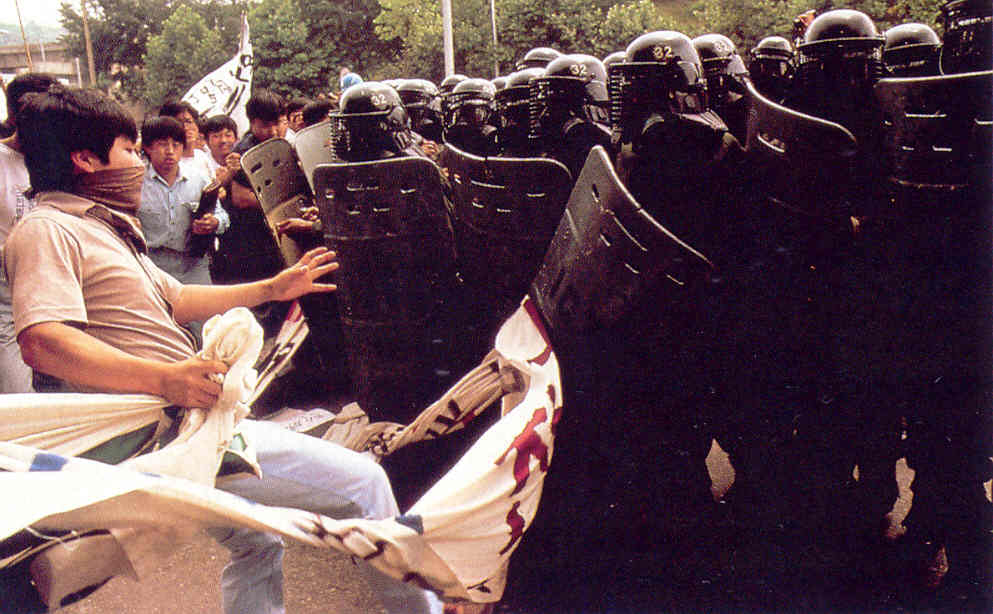
|
A rapidly expanding population constantly consumes all the economic gains of Latin America
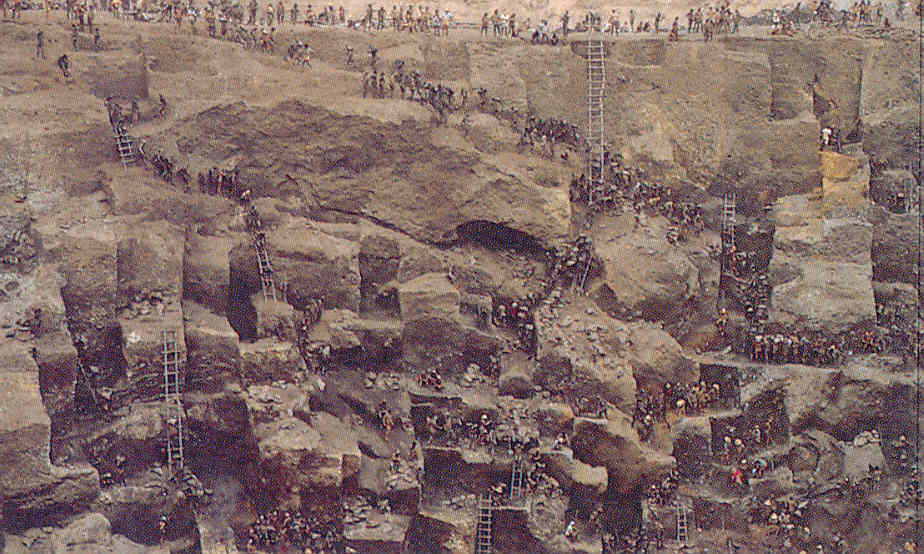
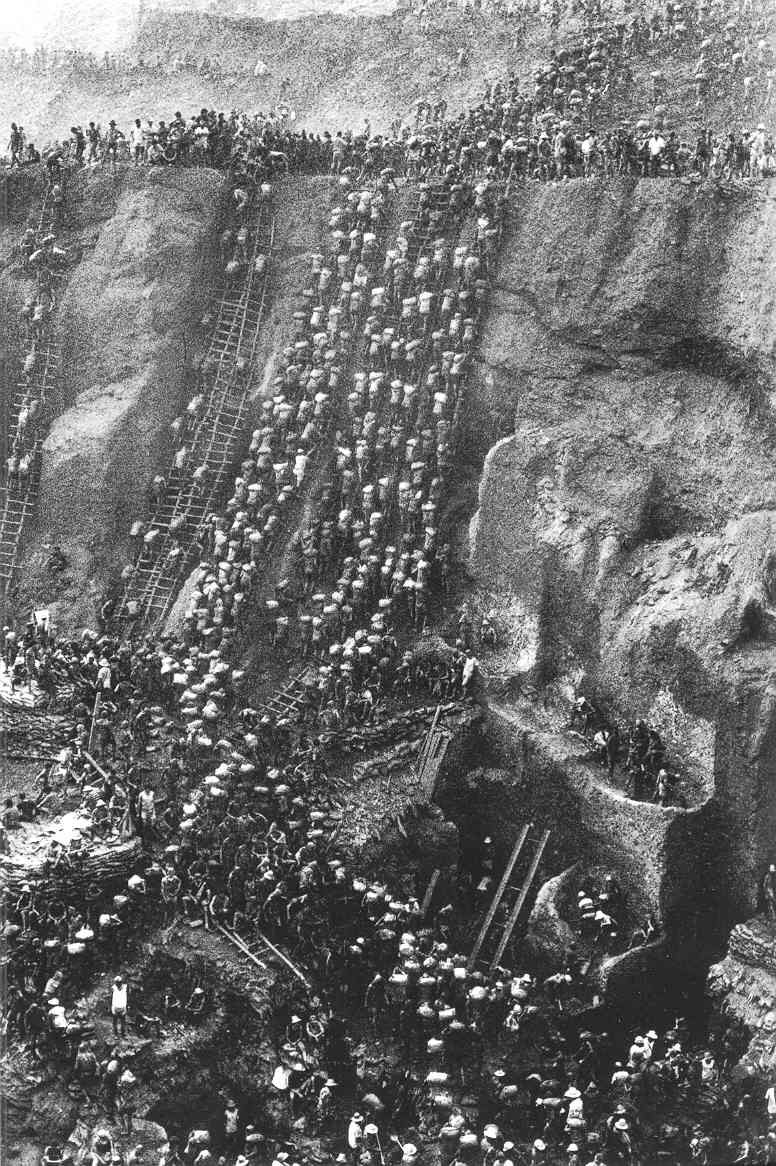
Goldmining in Serra Pelada,
Brazil - 1986
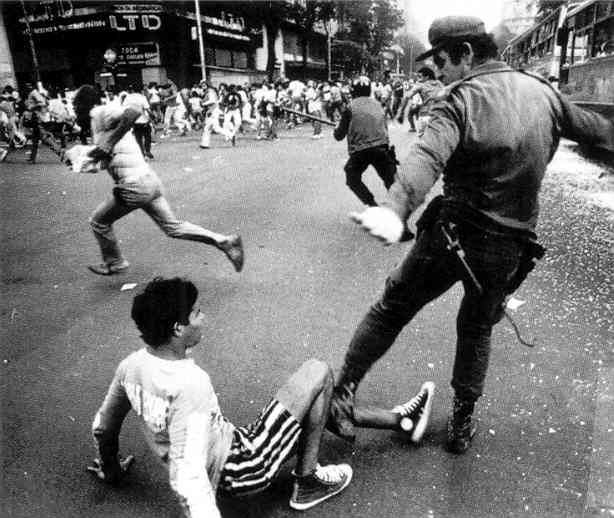
Deep economic troubles in
Brazil: Riots over bus-fare hike in Rio - 1987
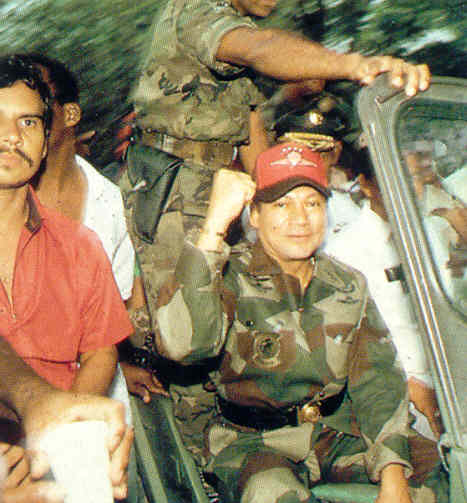
Panamanian dictator Manuel
Noriega
before being deposed by
an American military invasion in December of 1989
Violence in Central America (El Salvador) accompanies this demographic stress
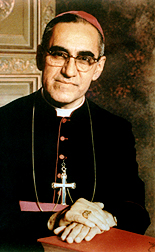
Salvadoran Archbishop Oscar
Romero - assassinated while conducting mass on March 24, 1980
after urging Salvadoran
soldiers not to obey the commands of their officers to murder civilians.
At his funeral 42 mourners
were shot down by army snipers ... to intimidate his followers.
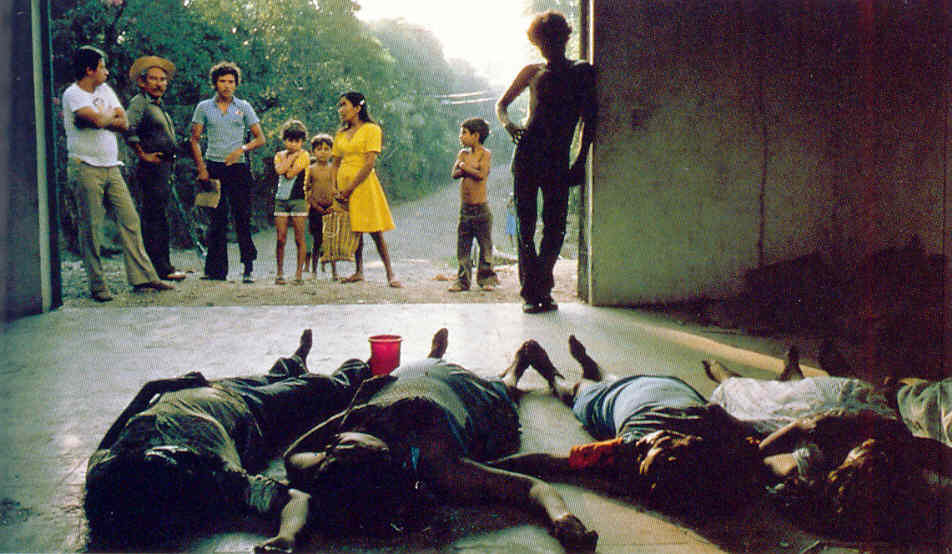
Five Salvadoran women tortured and killed by an ultra-conservative death squad - 1980
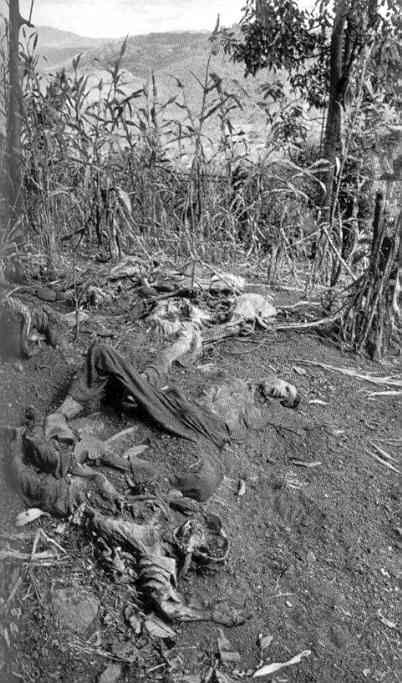
Some of the victims of the
El Mozote massacre in 1981
(reports were denied by
the US-backed regime;
records and remains of 794
victims were finally uncovered in 1991 - almost half of them children)
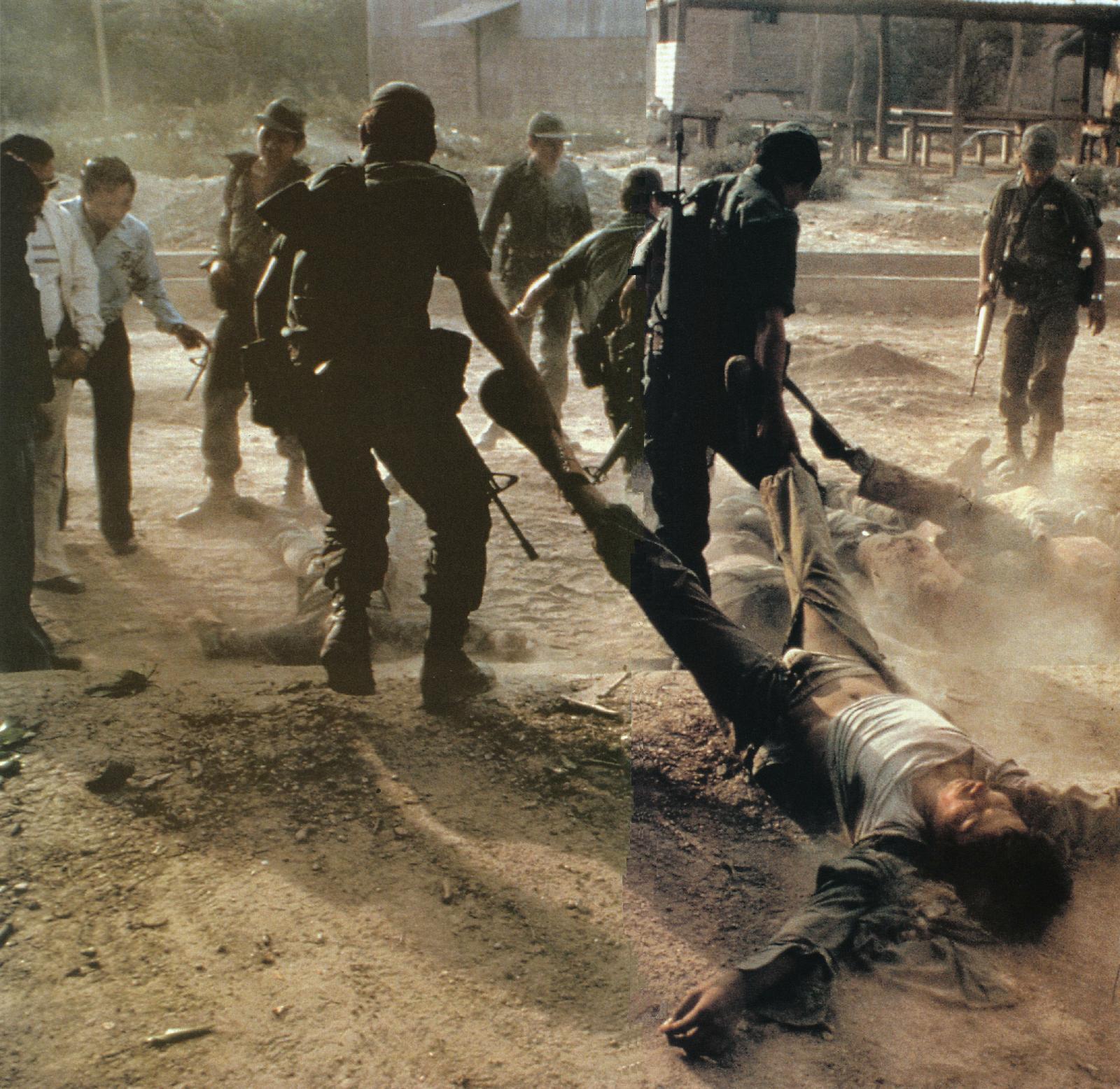
Troops clear dead Leftists
from the streets of suburban San Salvador - 1982
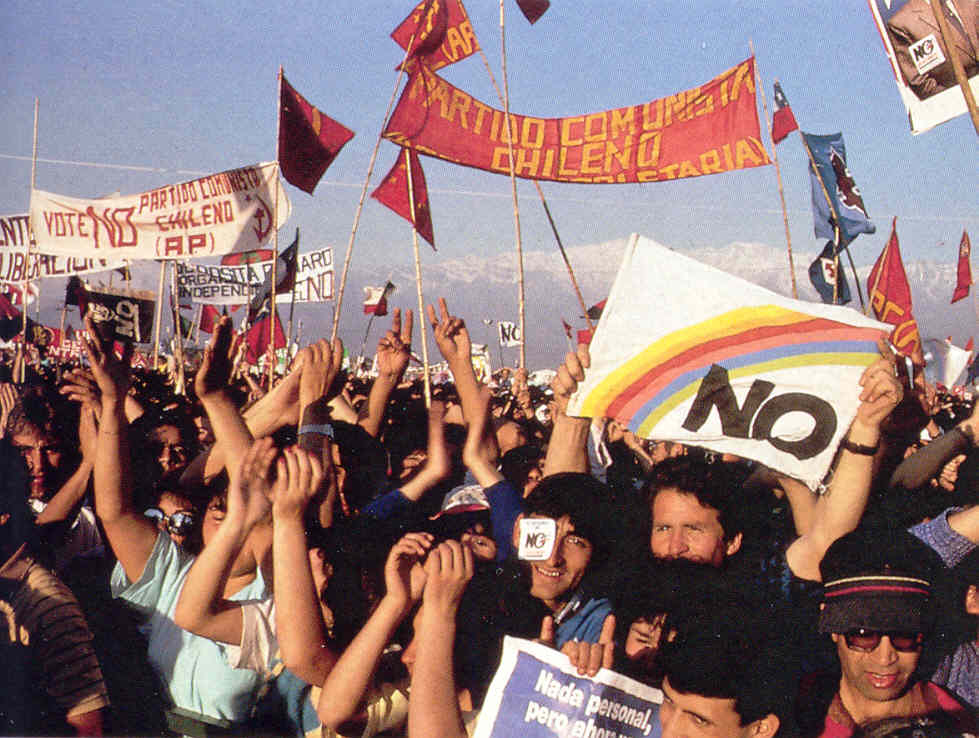
|
|
A growing spirit of jihadism (the call to fight against the 'evil' West) Over the years since the overthrow of
the Shah of Iran in 1979 Islam had taken on an increasingly militant anti-Western
stance. Whatever Arabs, Iranians, Turks, etc. had hoped that copying
Western culture might yield, by the 1980s they had begun to lose confidence
in that hope. They were also very bitter about the treatment of their
fellow Arabs, the Palestinians, who had been run out of their homes, their
shops and their farms – to make way for Western Jews pouring in from Europe
after World War Two. The fact that the West, and America in particular,
always seemed to take the Jewish or Israeli side – supporting Israel with
guns, tanks and airplanes (though the Israelis soon developed a number
of armaments industries of their own) – angered the Arabs deeply.
Finally, seeing America helplessly lose its most faithful ally in the Middle
East, the Shah of Iran, and equally helplessly unable to do anything about
the fervently anti-American Islamic Republic that replaced the Shah’s government,
served to greatly embolden a growing number of Islamic jihadists who vowed
to inflicting as much pain and death as possible on the West, and in particular
the ‘Great Satan,’ America. |
|
A number of Arab states (Egypt, Libya,
Syria, Iraq), actually quite secular in character (Arab ‘Socialist’), had
taken strong anti-Western positions with the growing Arab irritation with
the Israeli ‘intrusion.’ They had engaged Israel in war several
times from the 1950s through the 1970s.
Sadat and Mubarak's Egypt However, since the time of Egyptian
President Anwar as-Sadat in the mid-1970s – and after his assassination
by Muslim fundamentalists in 1981 with the presidency of Hosni Mubarak
(still in power as Egyptian President) - Egypt turned to the West, principally
the United States for close friendship. Both of these Egyptian presidents, whose regimes were quite secular in nature, well understood the dangers of Islamic fundamentalism, the need to have peaceful relations with Egypt’s neighbor Israel, and the need for the vital support of the United States to give muscle to this policy. |
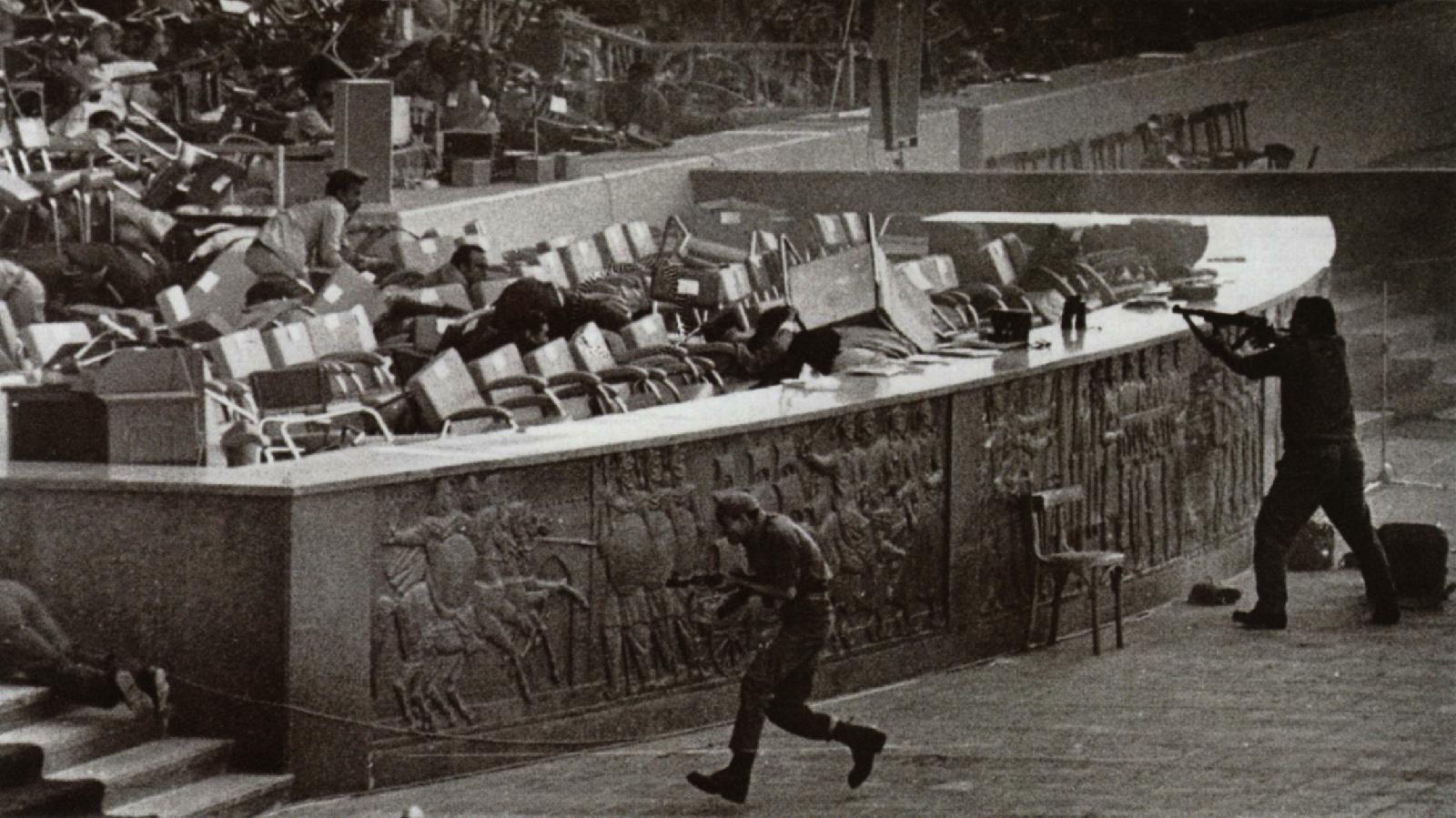
Egyptian President Anwar
Sadat assassinated by Muslim fundamentalists - October 6, 1981.
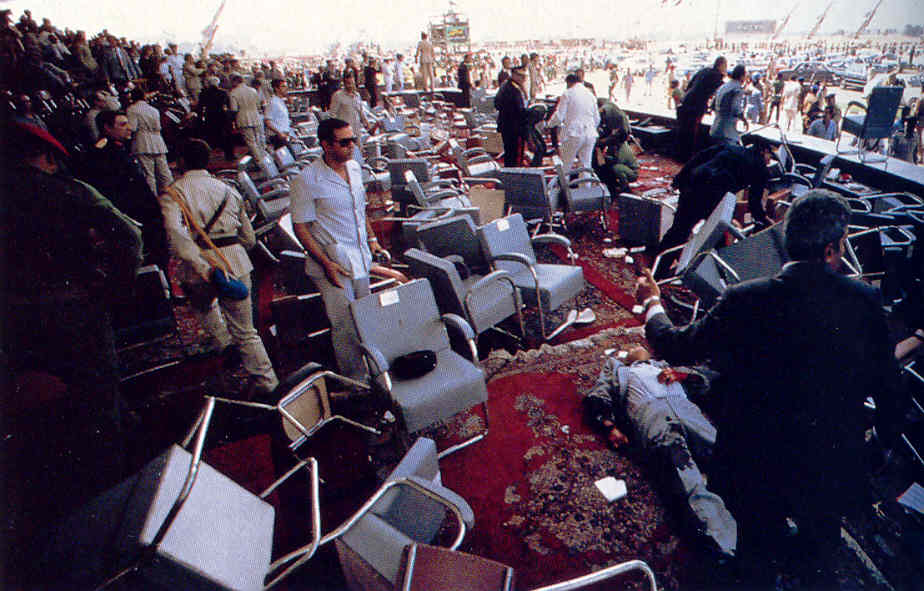
Gaddafi's Libya With the cooling of Arab nationalism in Egypt there was almost an automatic transfer of radical nationalism next door to Libya. Under the presidency of a young Muammar al-Gaddafi, Libya became a ‘socialist’ state with a very strong pro-Soviet orientation. He came down hard on Italians living in Libya (former colonials who now had to flee the country) and any intellectuals opposing him or his policies (many were murdered abroad by special Libyan agents). His country became a haven for radicals of all sorts – Irish, German, Japanese as well as Arab terrorist groups – and Libya's enormous wealth in oil and natural gas helped him finance a number of other anti-Western terrorist groups around the world. Reagan's attack on Gaddafi's presidential palace (April 1986). In 1986 Gaddafi had been behind the bombing of a Berlin discotheque which a number of US soldiers frequented – and Reagan retaliated by sending patrol boats into the Gulf of Sidra – which the Libyans fired on. This in turn led to a massive air attack on Gaddafi’s presidential palace. The United Nations howled and passed a resolution condemning the United States for this attack. But a number of countries stood with the United States. And the Soviet Union spoke out against the attack – but was unwilling to give any comfort to Libya because the Soviets themselves were becoming concerned about some of the rogue actions of their Libyan ally. This event began the backing away of Soviet support for Libya.
Libyan dictator Muammar al-Qaddafi
- 1981 |
The PLO. But with time the real struggle for Arab rights would be fought not by Arab states but by non-state organizations that had no official location in the Middle East, but simply drifted back and forth across Arab national boundaries in conducting their anti-Israeli, anti-West, anti-American ‘missions.’ The oldest of such Arab non-state organizations in the Middle East (formed in the 1960s) was the Palestinian Liberation Organization (PLO). It was officially sponsored by the Arab League and supported financially by a number of Arab states. Its mission was more particularly focused on removing the Jewish ‘intruders’ from the PLO’s homeland, Palestine. Hizbollah. Another Arab organization, Hezbollah,
grew up in the early 1980s and reflected a new Shi’ite militancy coming
from Iran after the Shah’s overthrow. [Iran was/is staunchly Shi’ite,
whereas the rest of the Muslim Middle East tends to be Sunni; the two wings
of Islam have an intense dislike of each other.] Indeed, Hizbollah
was formed up with the help of Iran for the purpose of supporting the Shi’ites
living in multi-ethnic Lebanon (Sunnis, Druzes, Christians and others,
as well as Shi’ites). |
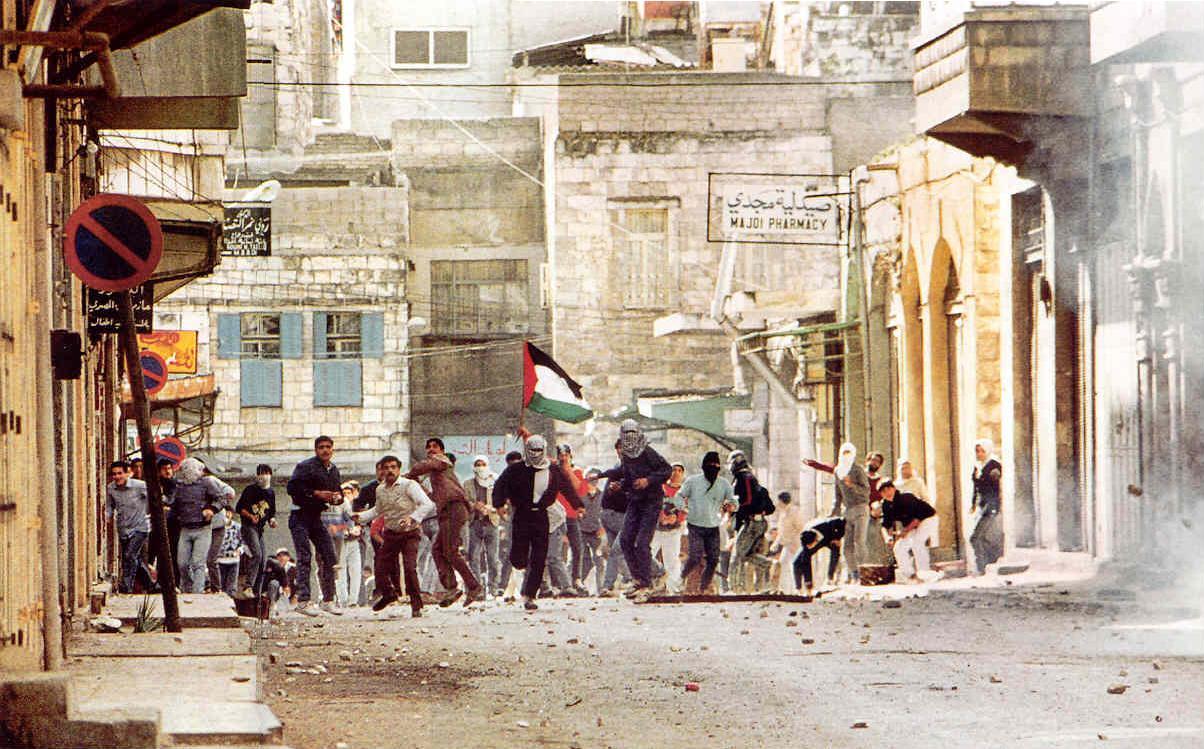
The Intifida reaches
Jerusalem when Arab shopkeepers shut down their shops
in protest against the Israeli
occupation - December 12, 1987.
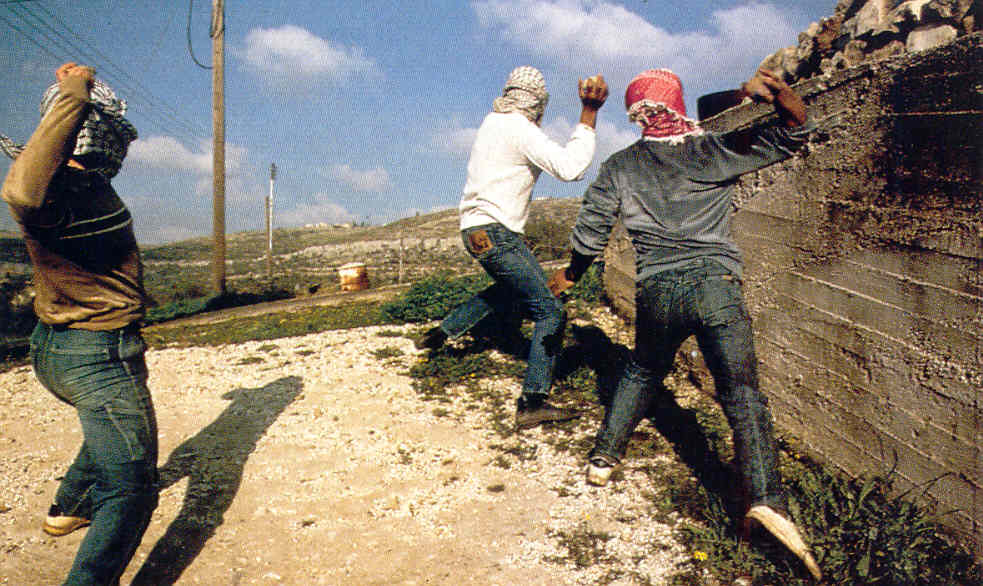
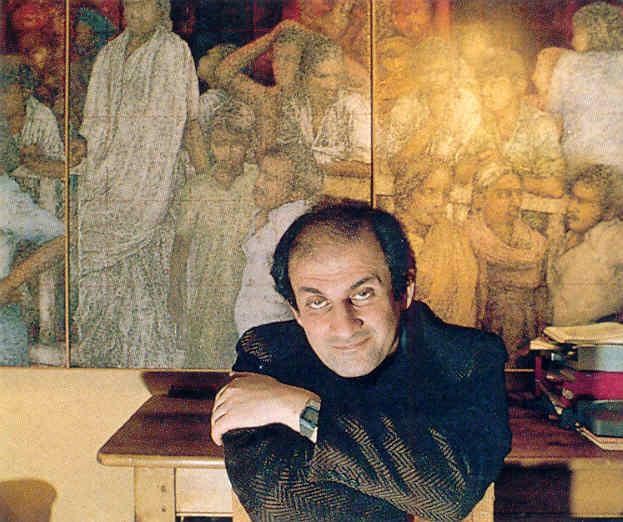
Salman Rushdie, author of
The Satanic Verses - 1988
The book drew for himself
a death warrant issued by Iran's theocratic dictator,
the Ayatollah Khomeini,
in 1989.
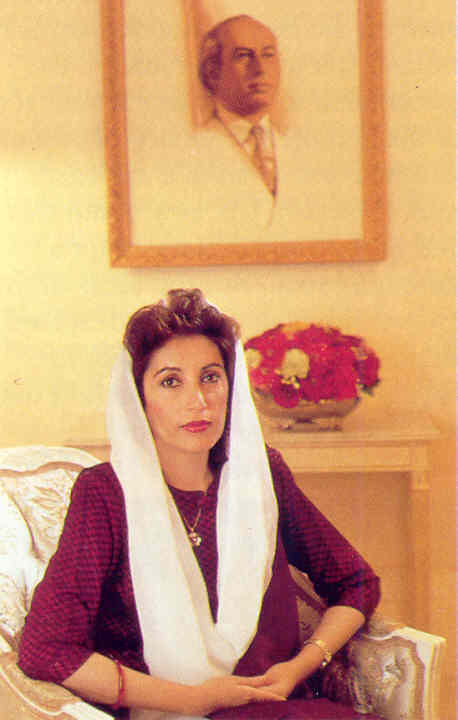
|
From White Rhodesia to Black Zimbabwe In
1987 Zimbabwe amended its constitution so as to give Mugabe virtually
unlimited powers: to dissoslve the Parliament at his own desire,
to remove the twenty parliamentary seats reserved for the country's
Whites, to run for an unlimited number of terms as President, and to
declare martial law as he himself personally chose to do so. Africa now had another dictator ... who would do what all African dictators did: use the country's resources as patronage to be distributed to his personal allies as he chose to do so ... and to shut down all voices of protest as he took total countrol of the country. This would work not only against the Whites, whose prosperous farms he would seize and award to his buddies (beginning in 1990) ... but also the other major Black parties - which he harrassed and eventually shut down (ZAPU in 1987 and then ZUM in 1989). His use of the 'Fifth Brigade' to supress Black oppostion (the mid 1980s) within his own country proved to be far worse than the loss of life during the earlier Black-White struggle for control of the nation (far, far more brutal). International outcries did not back Mugabe down from his move to crush any voice, or even potential voice, of oppotion to his dictatorial rule. At this point, the once highly prosperous Rhodesia/Zimbabwe began its long journey into deep poverty, until it went from one of the continent's richest countries to a society now struggling constantly with the deepest poverty, one which produced among its population Africa's highest rate of starvation, sickness and death. |
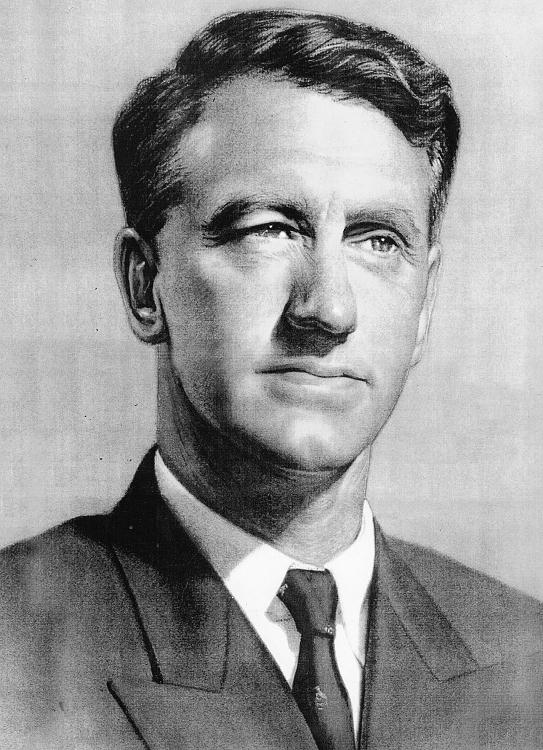
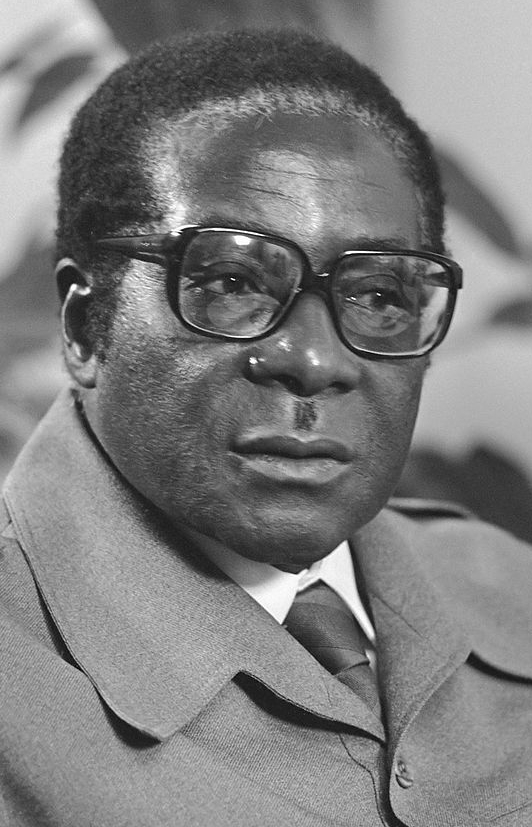
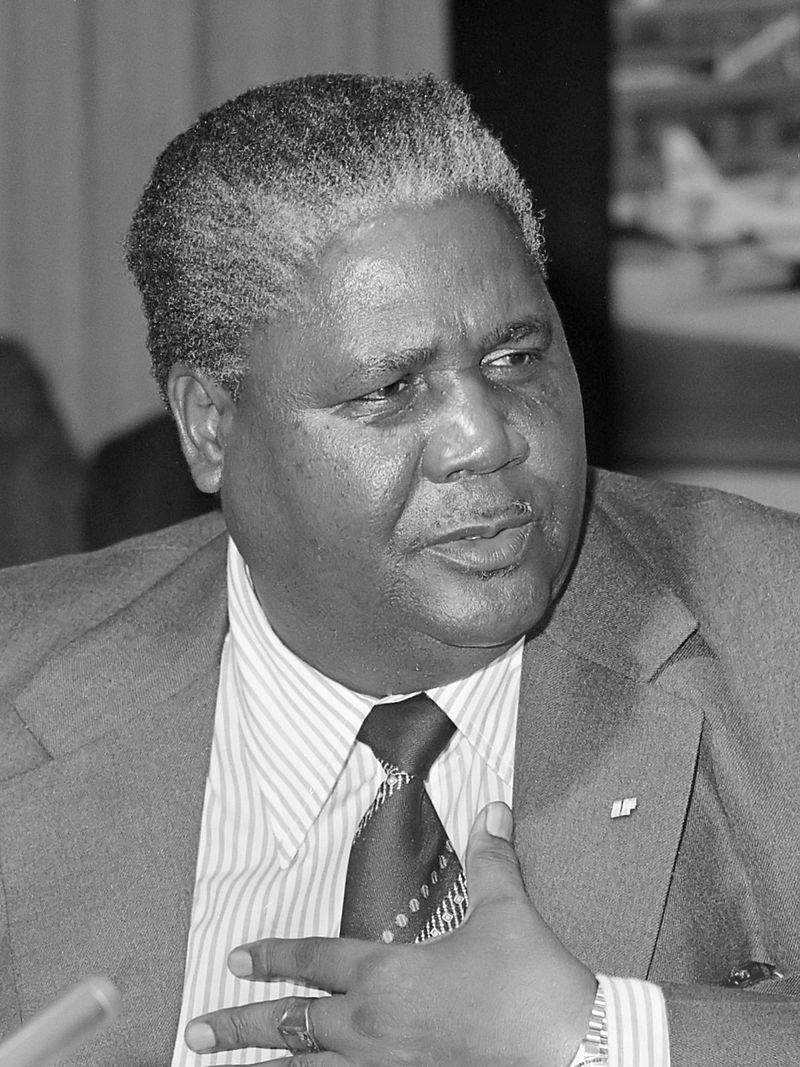
Ian Smith / Robert Mugabe / Joshua Nkomo
At the end of the 1980s / beginning of the 1990s, South Africa began its transition from White to Black rule
amazingly achieved without the accompanying violence the world was expecting1 ...
hopefully pointing to a better future for South Africa than was the case next door in Zimbabwe
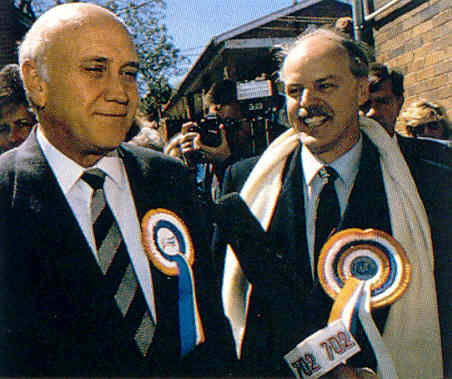
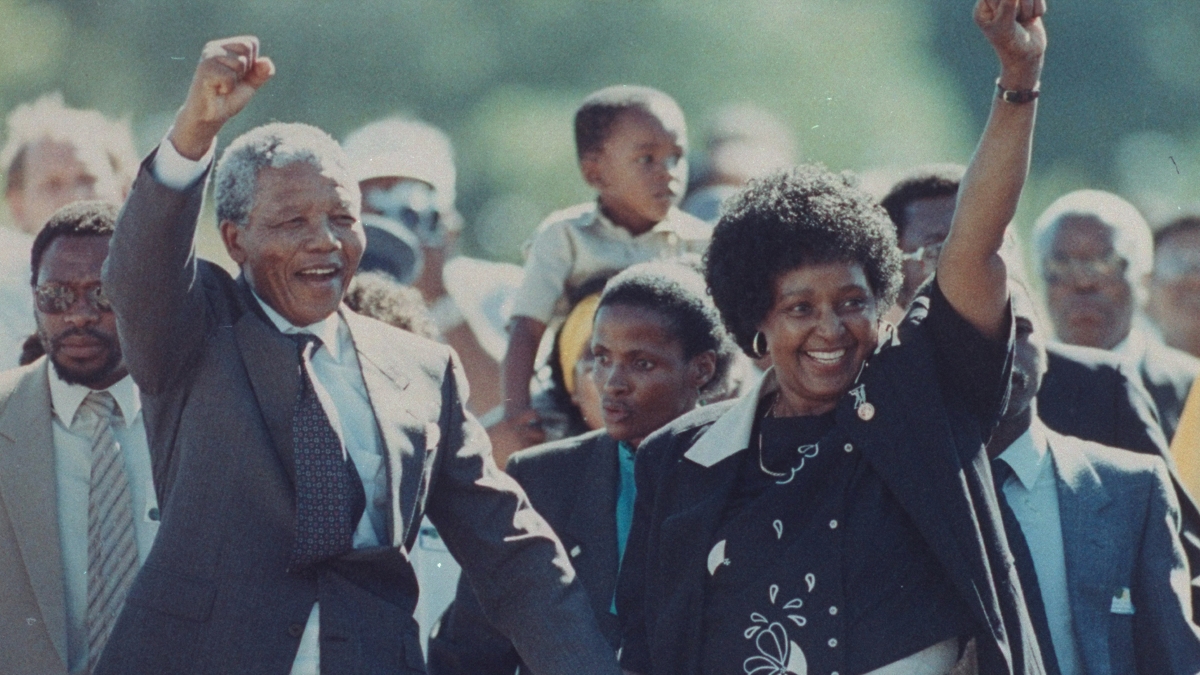
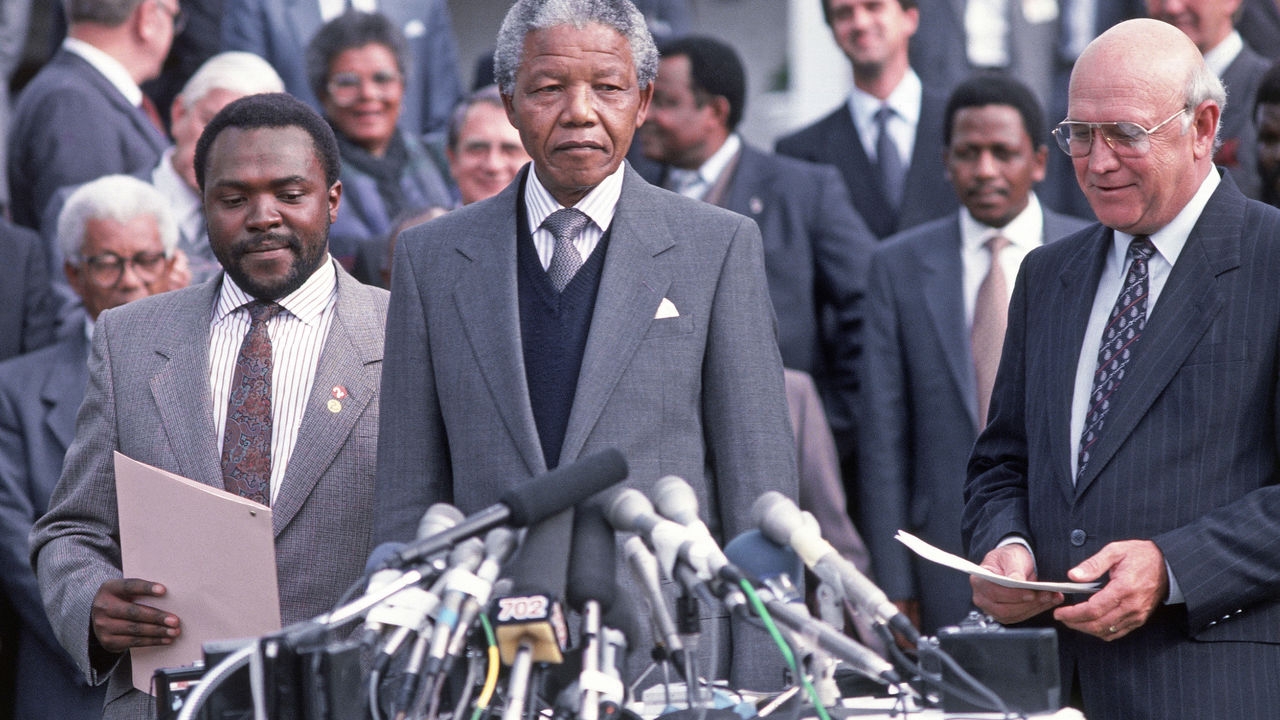
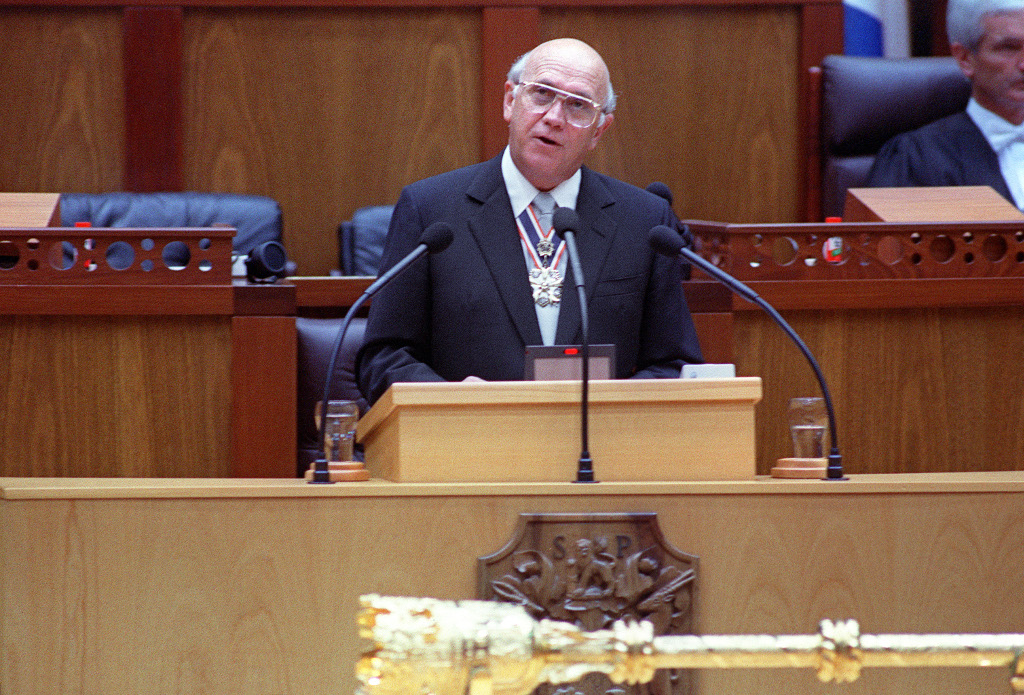
1In
1965 I submitted a 250-page master's thesis to Georgetown University in
which I concluded that the racial balance of power in South Africa was
such that I did not see, unlike what was happening in most of the
rest of Africa at the time, European (White) control of the country
changing racial hands for the forseeable future. Some
(though not my excellent mentor and highly informed 'Africanist,'
Victor Ferkiss ... who had suggested the topic to me in the first place)
were shocked at my conclusion, certain that I was being terribly naiive
about African politics. But in fact exactly what I had predicted
proved to be the case. A generation later (1988 to be exact) I spent the summer in South Africa interviewing a wide range of political-social leaders of South Africa ... and in early 1989 presented a 260-page senior thesis at Princeton Theological Seminary to my young mentor. He, however, was an avid 'Liberation Theologian' or: 'Jesus with a Machine Gun' type ... who actually knew nothing about South Africa itself beyond its ideological labels as 'racist' and 'ripe for revolution.' He was furious about my conclusion that some kind of unexpected spirit of 'racial reconciliation' was sweeping the country and that the country seemed to be preparing to make the transition from White to Black rule ... without any bloodshed likely to be involved in the process. He consequently turned in to the school Registrar the grade of 'F' for my thesis just days before graduation ... thinking to spare the seminary the humiliation of granting a degree to a naive student who had been taken in by White South African Fascists. He thus was most surprised to see me at graduation ceremonies. But the Registrar had taken the iniative on her own to switch my major from Christian ethics (the young professor's field) to Biblical studies ... as I had taken way more than enough Greek/Hebrew Biblical studies to qualify that as my major (I could in fact have graduated in two rather than three years ... except that Princeton had a 3-year residency requirement for the M.Div. Degree). In any case things soon turned out once again exactly as I had predicted they would. A few years later I ran into the young professor ... who, not too surprisingly, carefully avoided the subject of South Africa (anyway he was facing some really tough personal issues of his own at the time)! Ahh ... life in the academic bubble! |
|
From White Rhodesia to Black Zimbabwe In
1987 Zimbabwe amended its constitution so as to give Mugabe virtually
unlimited powers: to dissoslve the Parliament at his own desire,
to remove the twenty parliamentary seats reserved for the country's
Whites, to run for an unlimited number of terms as President, and to
declare martial law as he himself personally chose to do so. Africa now had another dictator ... who would do what all African dictators did: use the country's resources as patronage to be distributed to his personal allies as he chose to do so ... and to shut down all voices of protest as he took total countrol of the country. This would work not only against the Whites, whose prosperous farms he would seize and award to his buddies (beginning in 1990) ... but also the other major Black parties - which he harrassed and eventually shut down (ZAPU in 1987 and then ZUM in 1989). His use of the 'Fifth Brigade' to supress Black oppostion (the mid 1980s) within his own country proved to be far worse than the loss of life during the earlier Black-White struggle for control of the nation (far, far more brutal). International outcries did not back Mugabe down from his move to crush any voice, or even potential voice, of oppotion to his dictatorial rule. At this point, the once highly prosperous Rhodesia/Zimbabwe began its long journey into deep poverty, until it went from one of the continent's richest countries to a society now struggling constantly with the deepest poverty, one which produced among its population Africa's highest rate of starvation, sickness and death. |
|
|
The Soviet republics begin to move to full national independence The departure of the East European nations from the Soviet Empire was the signal for the Soviet Union itself to begin to crumble. Gorbachev had hoped that by softening the hand of Communism he might reverse the apathy of his people to the Communist order and bring them back to its support. But the response he received was instead for the many ethnic minority ‘republics’ to begin to press for the same freedoms recently received by the people in Eastern Europe. They wanted total national independence. The first to press the issue at various points in 1989 were the three Baltic states, Estonia, Latvia and Lithuania. By the beginning of 1990 almost all the other minority republics – most importantly Ukraine – were demanding some form of national independence. The
Communist Party itself was at
this point no longer in tight control of the situation. The Gorbachev
reforms had brought other groups into national politics in the newly created
and empowered Soviet Parliament (the Congress of People’s Deputies),
considerably
weakening Gorbachev’s and the Communist Party’s hold over the political
situation. Under Moscow’s mayor Yeltsin (who had abandoned his
Communist
label) even the huge Russian Federation was demanding independence.
Gorbachev was rapidly losing control over a crumbling Soviet
Union. The failed attempt by Communist
hardliners to seize power
In August of 1991 angry Communist hardliners inside the Gorbachev cabinet moved to take matters in their own hands and clamp down on the reforms – and Gorbachev. A coup was planned by Communist Party and Soviet military leaders to take place while Gorbachev was away on a visit to his vacation home in Crimea. The coup began with the house arrest of Gorbachev in Crimea. Tanks were simultaneously sent into Moscow. But thousands of Russians turned out into the Moscow streets to protest the coup. For three days the plotters and their supporters secluded themselves in the Russian Parliament building - while opposition to them outside mounted, led by Moscow mayor and President of the new Russian Federation, Boris Yeltsin. Yeltsin jumped aboard a tank to encourage the crowd to resist the coup. Soldiers balked at the thought of firing on the crowds and the military effort disintegrated. Finding themselves with virtually no popular support, the coup leaders finally had to back down. The coup had collapsed - and its leaders were arrested. Gorbachev was released and returned to Moscow. But he found that the coup had not only undercut severely the old Communists, but ultimately the coup succeeded only in stripping the last bit of authority away from Gorbachev and moving Yeltsin as the voice of the new ‘Russia’ into front and center position. |
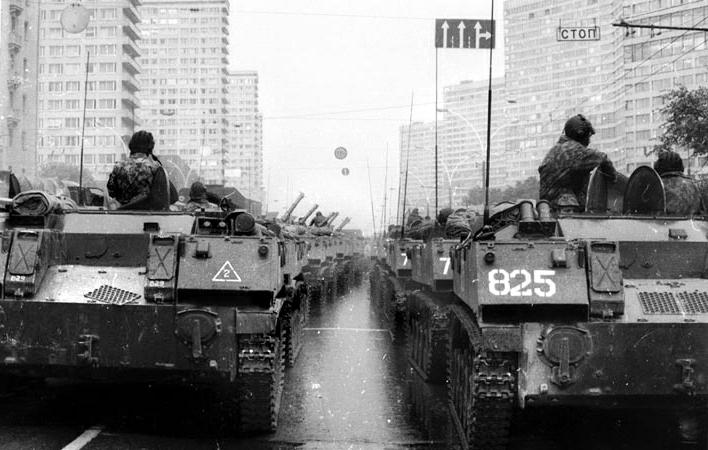
Tanks on Kalininsky Prospekt
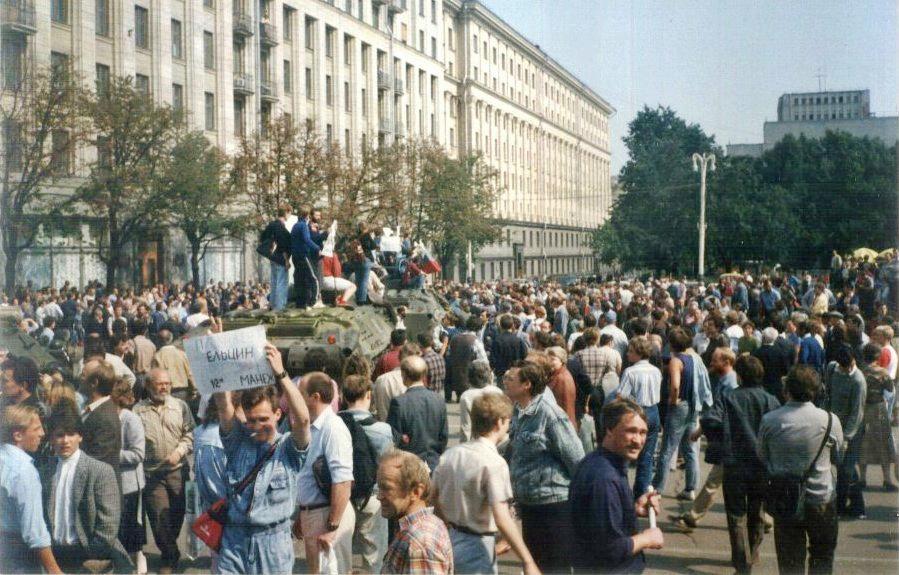
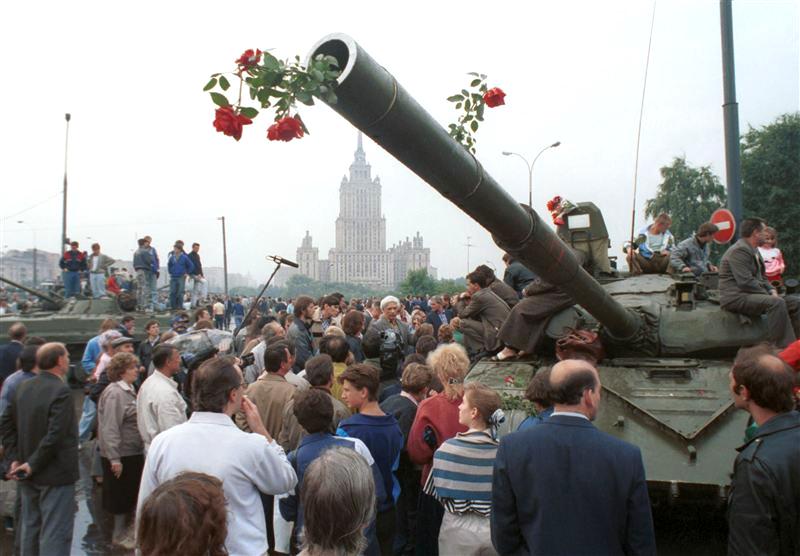
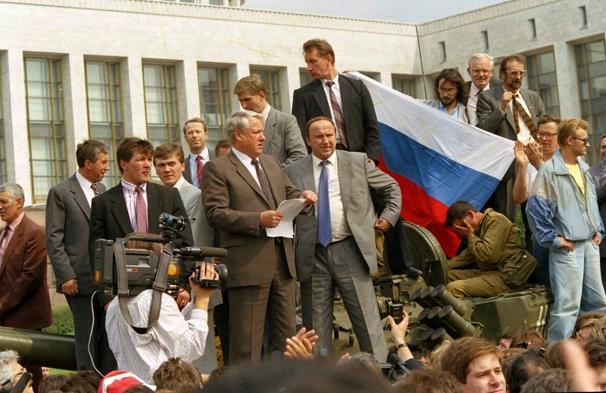
Boris Yeltsin on a tank addressing fellow Moscovites
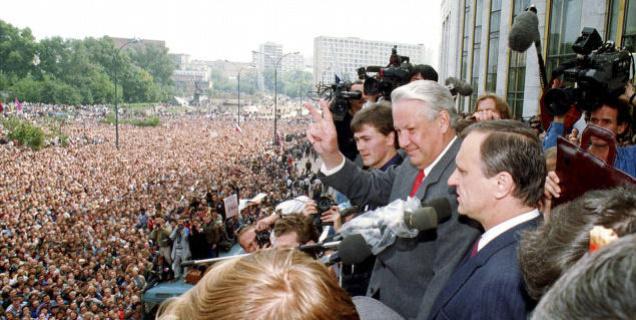
Boris Yeltsin addresses the Moscow crowd
|
December 1991 - Gorbachev Resigns - and the Soviet Union is no more A few months later, in December of 1991, Gobachev resigned the presidency of the Soviet Union - which then simply formally ceased to exist. The Soviet Union was dead. Where there had been a number of Soviet republics that once made up the Soviet Union, there were now 15 independent political states, including 'Russia' which was now considered a fully independent nation - under the presidency of Boris Yeltsin. |
